Nicaragua is home to a diverse range of bird species, from the brightly-colored Scarlet Macaw to the majestic Resplendent Quetzal. This Central American country is a haven for bird-watchers, boasting a wide array of native and migratory species.
With its varied landscape, Nicaragua’s birds can be found in its many forests, wetlands, and plains. From tropical lowlands to cloud forests in the highlands, Nicaragua offers a variety of safe havens for its avian population.We will discuss some of the most common and remarkable birds of Nicaragua.
1. Turquoise-Browed Motmot
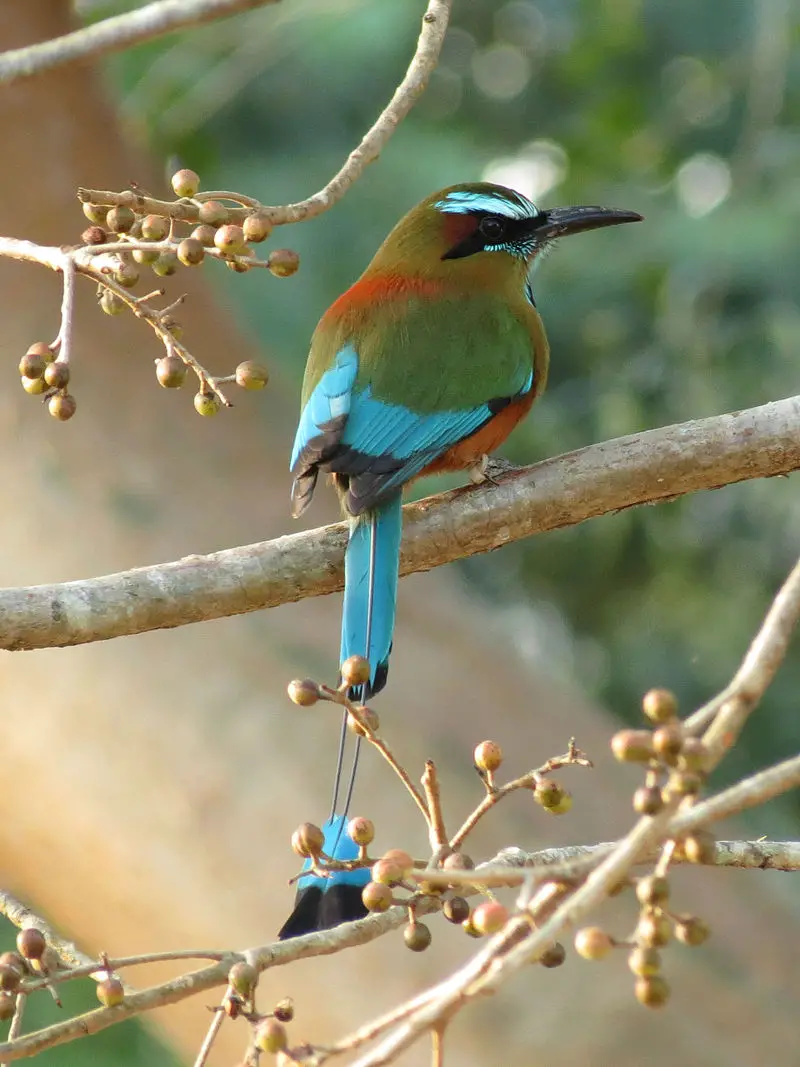
The turquoise-browed motmot is a beautiful bird of the Momotidae family. It can be found in central America from south east Mexico to Costa Rica, where it is common and not considered threatened.
This species enjoys living in open habitats such as forest edges, gallery forests or scrubland.
They are more visible than other Motmots due to their large size and bright colouration which includes an iridescent blue back and yellowish chest with black spots on its throat feathers.
Turquoise-browed motmots possess unique features that set them apart; they have two long tail feathers which dangle behind them while flying like streamers, hence earning themselves the nickname “the flying orchestra”.
In addition they are known for their loud calls during mating season – making them easily recognizable.
Scientific classification:
| Kingdom | Animalia |
| Phylum | Chordata |
| Class | Aves |
| Order | Coraciiformes |
| Family | Momotidae |
| Genus | Eumomota P.L. Sclater, 1858 |
| Species | E. superciliosa |
2. Motmot
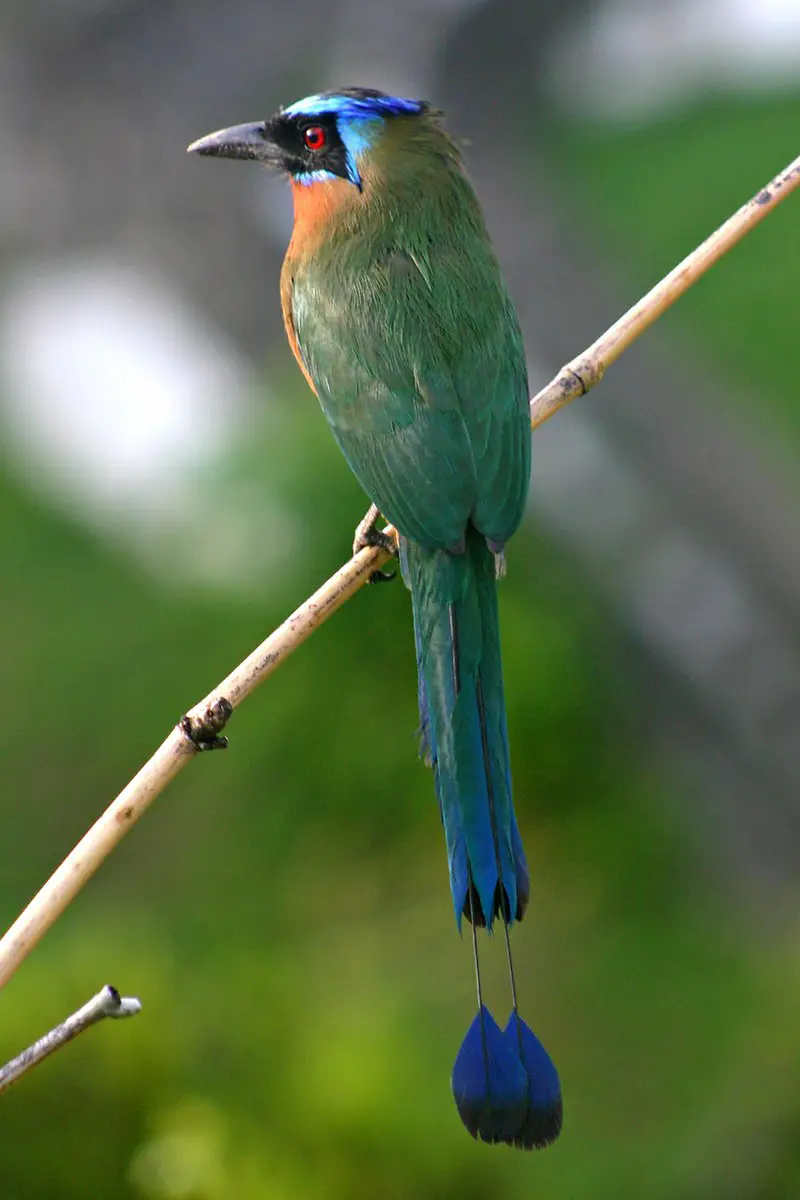
Motmots are a family of birds in the order Coraciiformes, known for their vibrant plumage and relatively heavy bills. They inhabit woodlands or forests across the Neotropics and can range in size from small to large.
The most distinctive feature of motmot species is their long tail feathers that some have adorned with unique patterns like eyespots.
Their diet consists mainly of insects but they will also eat smaller vertebrates such as lizards, frogs and fish.
Motmots are active during daylight hours where they can be seen perching on branches along forest edges or flitting through trees hunting prey.
These beautiful creatures have become an important part of many peoples’ lives throughout Latin America due to them being considered symbols of good luck by local cultures.
Scientific classification:
| Kingdom | Animalia |
| Phylum | Chordata |
| Class | Aves |
| Order | Coraciiformes |
| Family | Momotidae GR Gray, 1840 |
3. Black-Cheeked Woodpecker
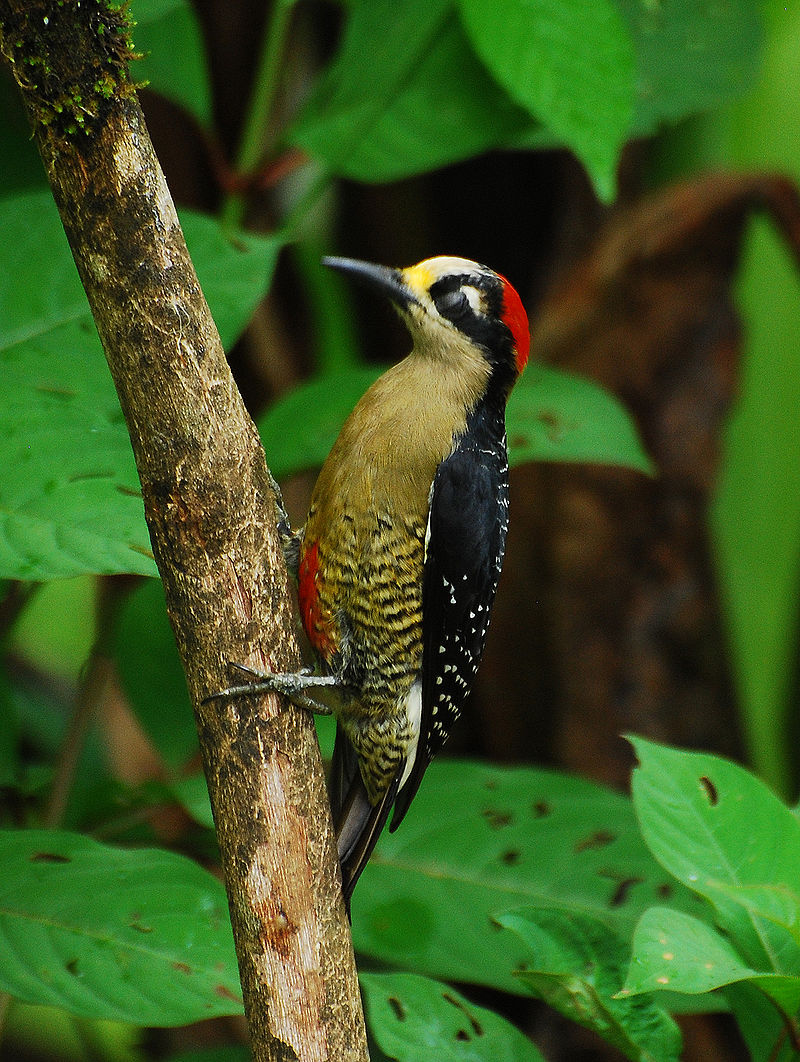
The Black-cheeked Woodpecker is a medium sized, colorful bird found in tropical regions of Mexico, Central America and Ecuador.
The species has black upperparts with patches of yellow and red on the wings as well as white underparts contrasted by its namesake black cheeks.
These birds are often seen foraging alone or in pairs through their preferred habitats: wet forests, semi-open woodlands and old secondary growths.
They nest high up in dead trees where they lay two to four glossy white eggs that both sexes incubate together until hatching time arrives.
This species bears the Latin name Melanerpes pucherani which commemorates an Italian naturalist who first described it over 200 years ago. A beautiful specimen of nature’s creations.
Scientific classification:
| Kingdom | Animalia |
| Phylum | Chordata |
| Class | Aves |
| Order | Piciformes |
| Family | Picidae |
| Genus | Melanerpes |
| Species | M. pucherani |
4. Yellow-Naped Amazon
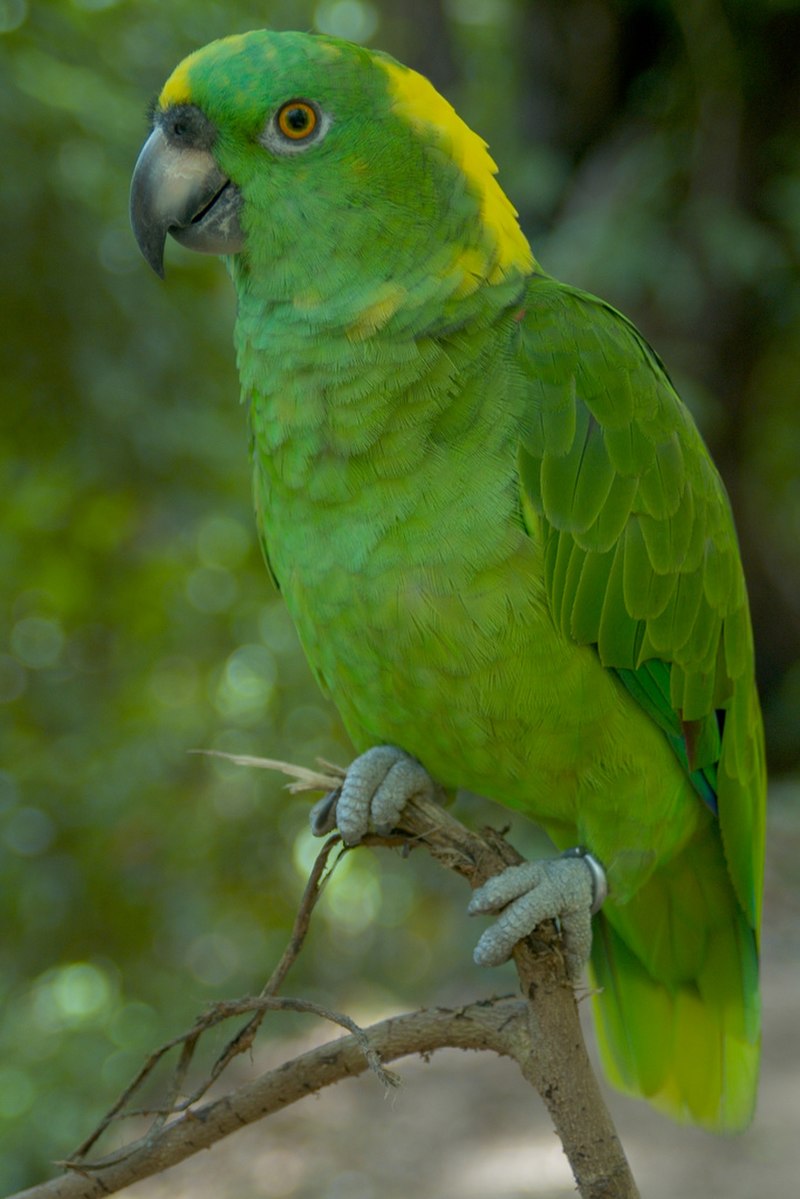
The Yellow-Naped Amazon is a beautiful parrot native to the Pacific coast of southern Mexico and Central America. Its vibrant yellow head feathers distinguish it from other species, making it an instantly recognizable bird.
This species has recently been classified as Critically Endangered due to its dramatic decline in population numbers over recent years.
The main threats this species faces are illegal trapping for the pet trade, habitat loss and fragmentation caused by deforestation and agricultural land conversion, as well as competition with locally introduced birds.
Conservation efforts must be implemented if we want to ensure that this majestic creature doesn’t disappear forever.
Scientific classification:
| Kingdom | Animalia |
| Phylum | Chordata |
| Class | Aves |
| Order | Psittaciformes |
| Family | Psittacidae |
| Genus | Amazona |
| Species | A. auropalliata |
5. Blue-Throated Goldentail
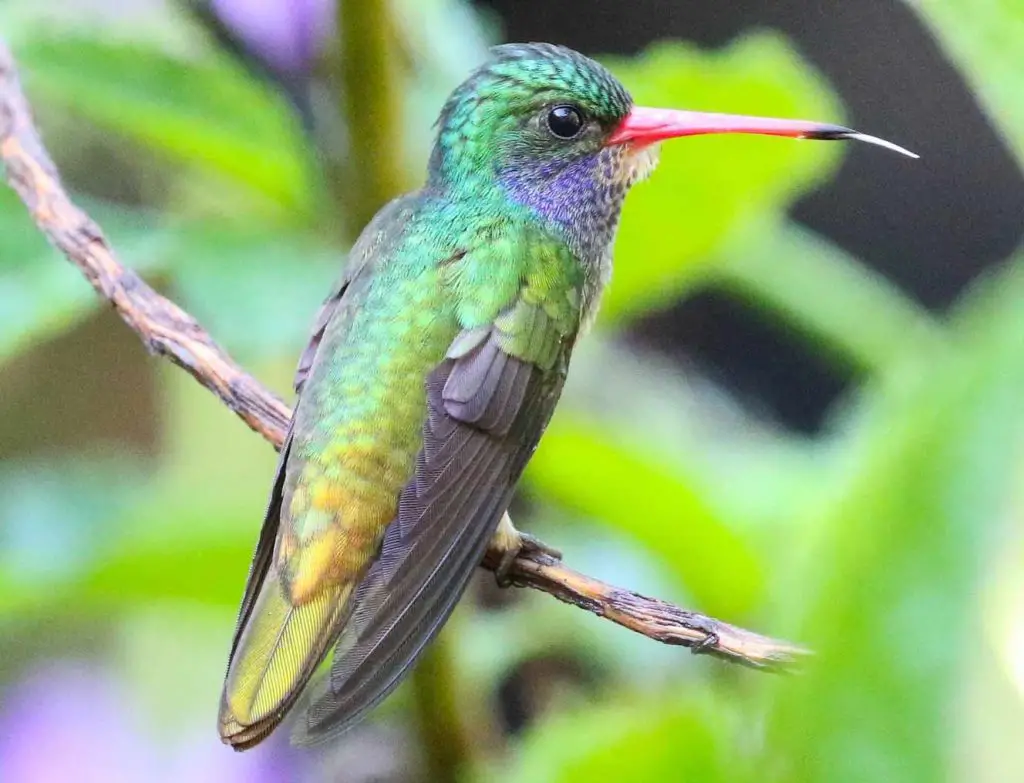
The Blue-throated Goldentail is a beautiful species of hummingbird found in Central America and Mexico.
This bird has an iridescent blue throat, dark green upper parts, white underparts with metalic sheen, and bright yellow tail feathers making it one of the most stunningly coloured birds around.
It can be seen flitting among trees looking for insects to eat or drinking nectar from flowers while hovering midair with its wings beating at incredible speeds.
Its natural habitats are lowland tropical forests but they have adapted to heavily degraded former forest areas too.
The male goldentails use their vibrant colours as part of their courtship display which involves song flights where they rise up into the air before plunging back down again showing off their spectacular plumage all along.
Scientific classification:
| Kingdom | Animalia |
| Phylum | Chordata |
| Class | Aves |
| Order | Apodiformes |
| Family | Trochilidae |
| Genus | Chlorestes |
| Species | C. eliciae |
6. Black-Headed Trogon
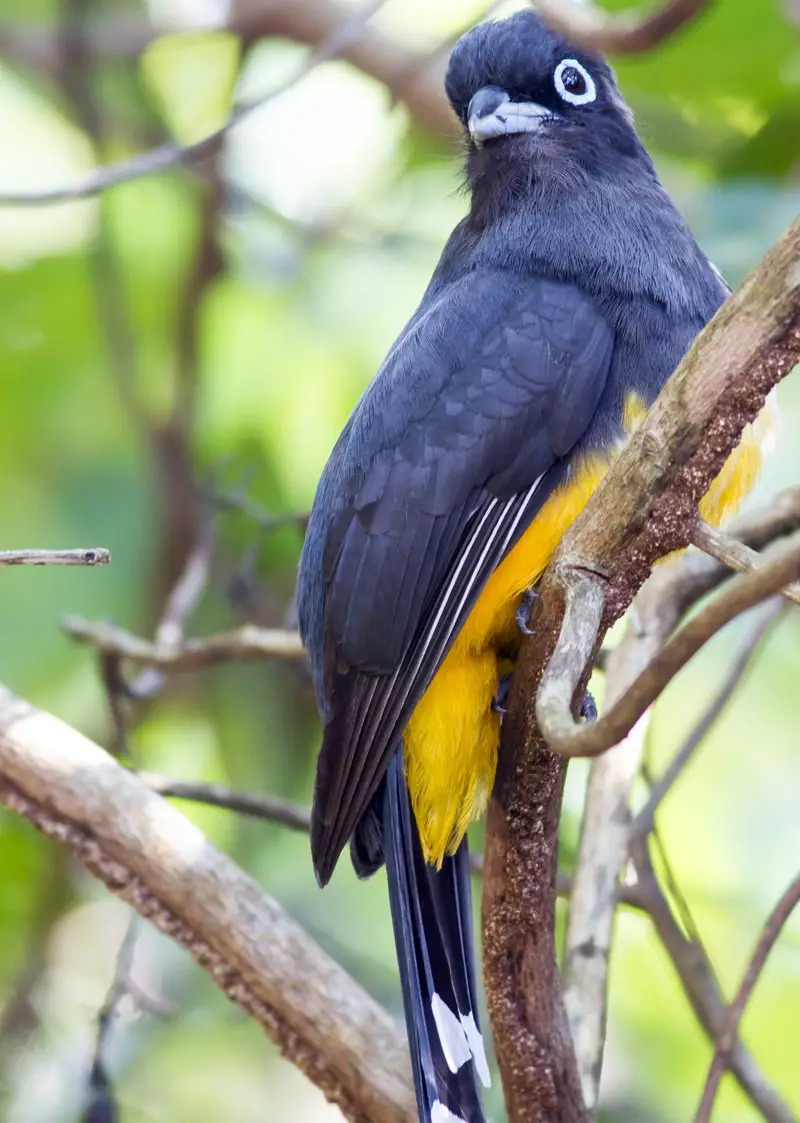
The Black-headed Trogon is a species of bird belonging to the family Trogonidae. It mainly resides in Central America, such as Belize, Costa Rica, El Salvador and Mexico.
The International Ornithological Committee and BirdLife International’s Handbook of the Birds of the World consider this species monotypic.
Clements taxonomy assigns it two subspecies – T. m. melanocephalus found from Honduras to Nicaragua; while T. m leucolaemus can be spotted in Guatemala and Chiapas (Mexico).
Its feathers are mostly black with white tips on wings & tail tip with red undertail coverts that make its appearance unique when seen against sunlight or bright background.
Scientific classification:
| Kingdom | Animalia |
| Phylum | Chordata |
| Class | Aves |
| Order | Trogoniformes |
| Family | Trogonidae |
| Genus | Trogon |
| Species | T. melanocephalus |
7. Black Hawk-Eagle
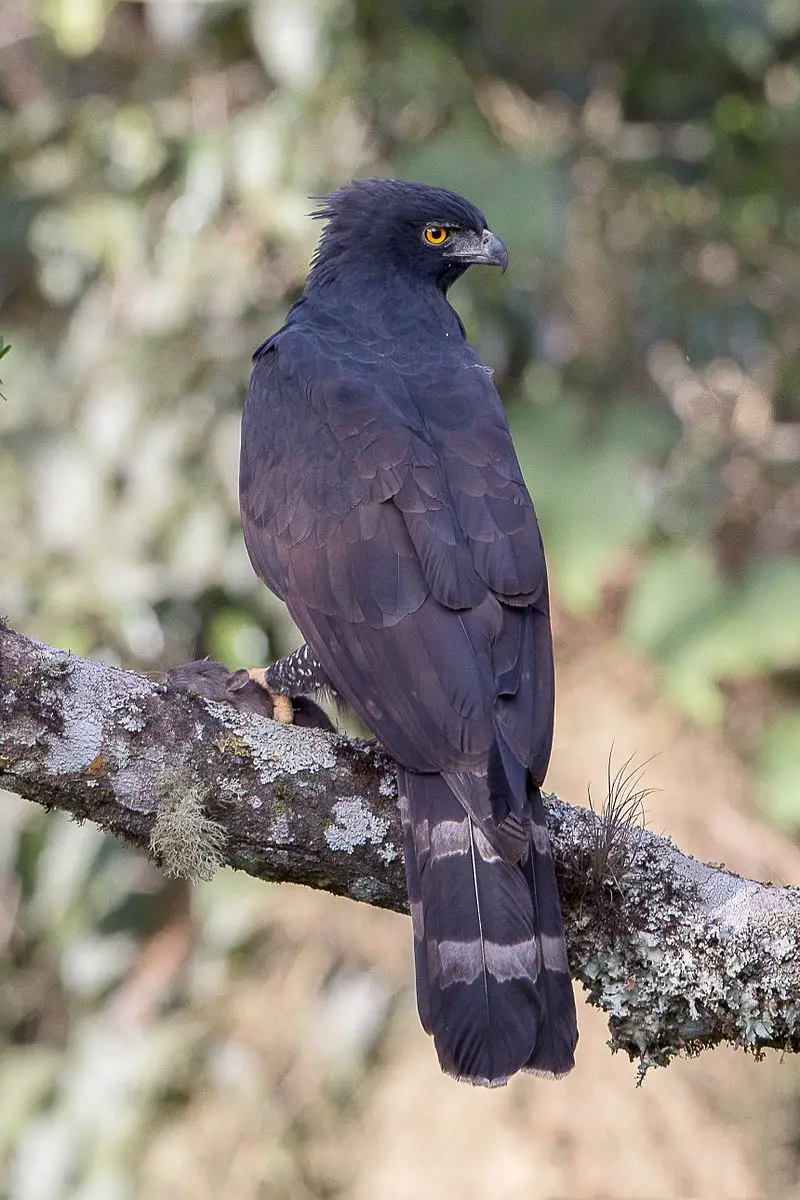
The Black Hawk-Eagle is a majestic bird of prey found throughout Central and South America. With its striking black plumage and distinctive white wing patches, this large eagle can soar gracefully in the air with ease.
It has two known subspecies: S.t tyrannus which is mostly found in Brazil and Argentina, while S. t serus inhabits other parts of Latin America such as Mexico to Colombia, eastern Peru, northern Argentina among others regions.
This beautiful raptor feeds mainly on small mammals like hares or birds but also enjoys carrion when available – it’s an opportunistic hunter that takes advantage of any food sources within reach.
The Black Hawk-Eagle plays an important role in many local ecosystems by controlling animal populations through predation yet they remain vulnerable due to habitat destruction from human activities such as urban expansion or unsustainable agricultural practices.
Scientific classification:
| Kingdom | Animalia |
| Phylum | Chordata |
| Class | Aves |
| Order | Accipitriformes |
| Family | Accipitridae |
| Genus | Spizaetus |
| Species | S. tyrannus |
8. Keel-Billed Toucan
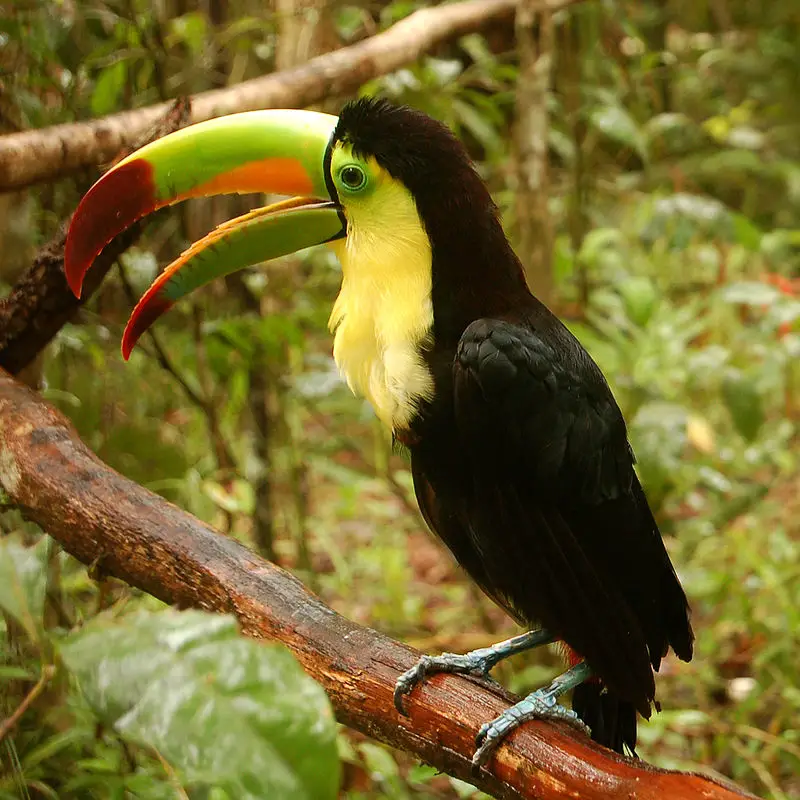
The Keel-billed Toucan is a vibrant Latin American bird from the toucan family and also serves as Belize’s national bird. They are found in tropical jungles stretching all the way from southern Mexico to Colombia.
They feed on fruits, seeds, insects, lizards and snakes – being omnivorous birds they eat pretty much anything.
These colourful creatures have an impressive beak with green upper parts of their bodies coupled with yellow lower halves.
The underside of their tail feathers are black while its tips remain white creating for quite a stunning display when flying or perched atop tree branches.
Scientific classification:
| Kingdom | Animalia |
| Phylum | Chordata |
| Class | Aves |
| Order | Piciformes |
| Family | Ramphastidae |
| Genus | Ramphastos |
| Species | R. sulfuratus |
9. Pauraque
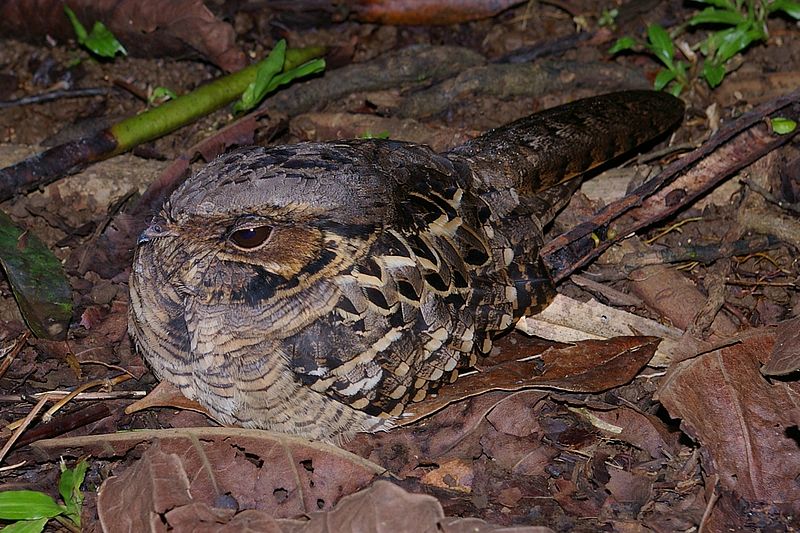
The Pauraque is a nightjar species belonging to the genus Nyctidromus and found in subtropical and tropical regions of the New World. It was formally described by German naturalist Johann in 1789.
Possessing unique features such as distinct white patches on its neck, it has adapted well to living near human settlements; making no noise during day time while roosting among tree branches or low shrubs in open areas with sparse vegetation like pastures, savannahs etc.,
The Pauraque feeds mainly on insects which helps reduce pest populations around agricultural fields.
This bird also plays an important role in maintaining healthy ecosystems across its range due to their habitat preferences for different stages of forest succession, from secondary growth forests to grasslands and scrublands.
Scientific classification:
| Kingdom | Animalia |
| Phylum | Chordata |
| Class | Aves |
| Order | Caprimulgiformes |
| Family | Caprimulgidae |
| Genus | Nyctidromus |
| Species | N. albicollis |
Also Featured In: Rainforest Birds You Should Know, Birds You’ll Find in South Texas
10. White-Throated Magpie-Jay
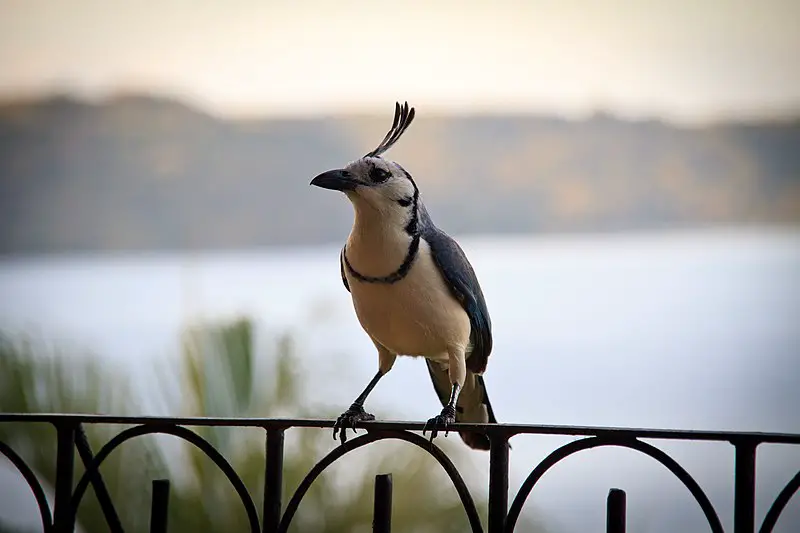
The White-throated Magpie-Jay is a large, gregarious bird native to Central America. It has an unmistakable white throat and black head with striking blue wings and tail feathers.
Its range extends from Jalisco, Mexico to Guanacaste in Costa Rica where it can be found inhabiting Pacific-slope thorn forest habitats.
This species of magpie was formally described by the English naturalist William John Swainson in 1827 and since then have become known for their noisey behavior which often includes mobbing any intruders into their territory.
They travel in flocks making them easy to spot but difficult for those who wish to avoid attention.
Scientific classification:
| Kingdom | Animalia |
| Phylum | Chordata |
| Class | Aves |
| Order | Passeriformes |
| Family | Corvidae |
| Genus | Calocitta |
| Species | C. formosa |
Also Featured In: Birds that You’ll Find in Chiapas,
11. Rufous-Capped Warbler
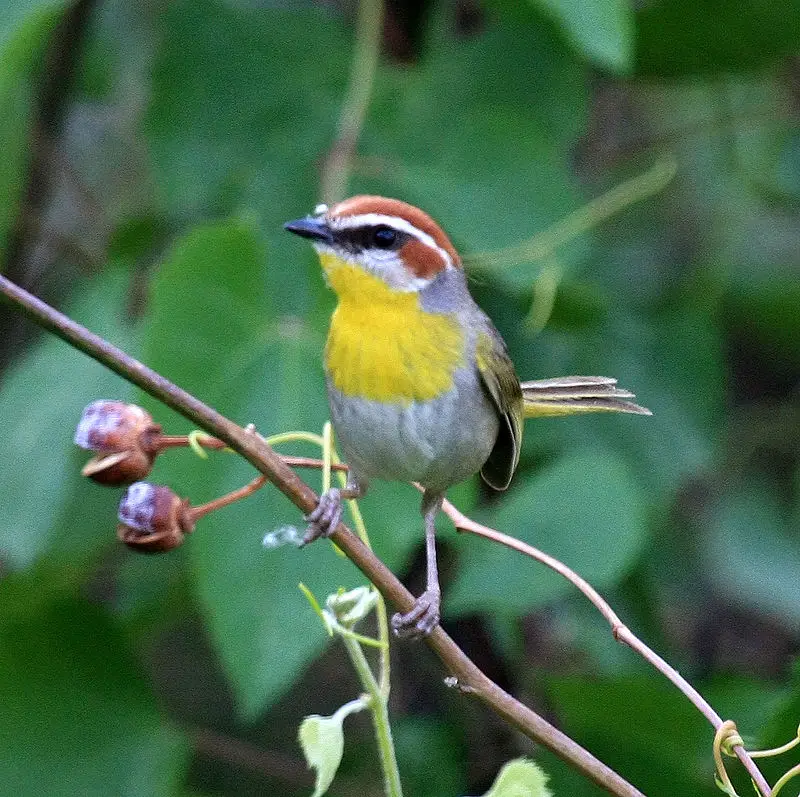
The Rufous-capped Warbler is a small New World warbler found mainly in Mexico and Guatemala.
It has distinctive chestnut-brown cap of feathers atop its head, along with olive green upperparts and yellowish underparts.
Subspecies living further south are sometimes considered as the Chestnut-Capped Warbler instead.
They usually reach 12.7 cm (5in) in length, making them one of the smaller species within their family.
As insectivores they feed on insects such as caterpillars but will also consume fruits when available and breed from March to June depending on location; nesting either close to or above ground using mosses, lichens, grasses, spider webs etc for construction material.
Scientific classification:
| Kingdom | Animalia |
| Phylum | Chordata |
| Class | Aves |
| Order | Passeriformes |
| Family | Parulidae |
| Genus | Basileuterus |
| Species | B. rufifrons |
Also Featured In: Most Common Birds of Nuevo Leon, Common Birds of Mexico City
12. Pacific Parakeet
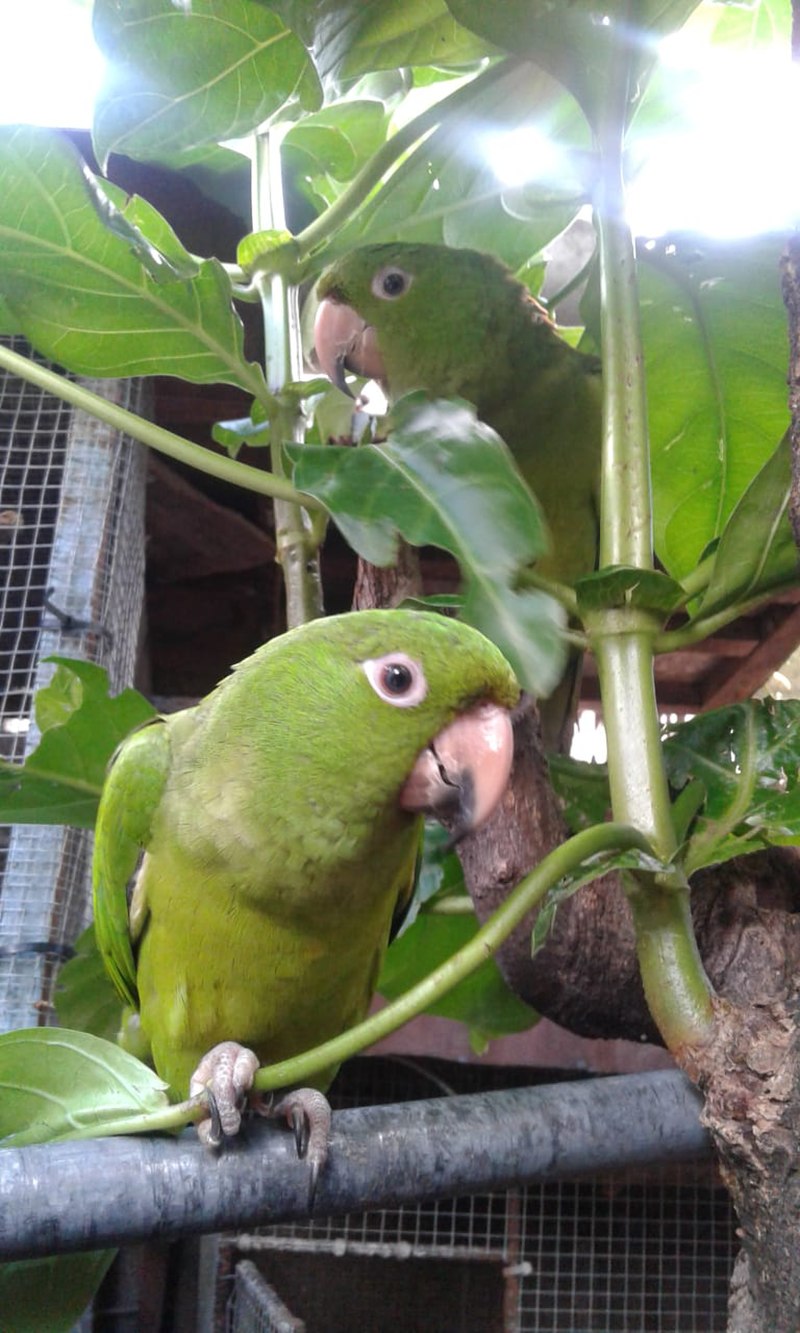
The Pacific parakeet is a species of parakeet that can be found in the Chocoyero-El Brujo Natural Reserve, located in western Nicaragua. It has bright green feathers with pale yellow stripes on its wings and tail.
This bird usually feeds on fruits, seeds, buds and blossoms from trees or shrubs.
The Pacific Parakeets mate for life and form flocks together to protect their nesting sites which are generally holes within tree trunks or branches near water sources such as rivers or lakes.
These birds have an average lifespan of 15 years but may live up to 30 years if well cared for in captivity.
They require plenty of open space along with hiding spots like boxes so they feel safe enough to explore their environment freely.
Scientific classification:
| Kingdom | Animalia |
| Phylum | Chordata |
| Class | Aves |
| Order | Psittaciformes |
| Family | Psittacidae |
| Genus | Psittacara |
| Species | P. strenuus |
13. Banded Wren
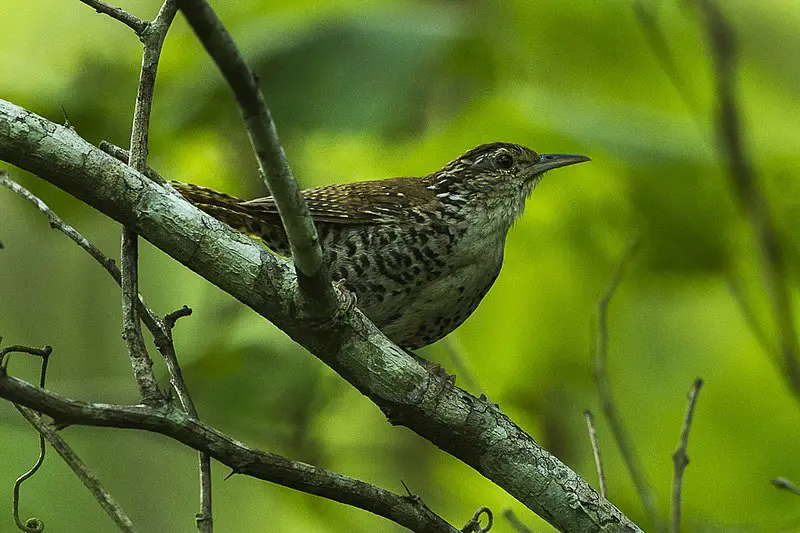
The Banded Wren is a small songbird of the wren family that can be found in Central Mexico to Costa Rica.
It resides and breeds best in open or scrubby woodlands, forest clearings, second growth areas as well as lowlands and foothills ranging from sea level up to 800 meters altitude.
This bird has a unique feature; its plumage varies depending on location with some having white bands across their backs while others have black ones instead.
The male banded wrens are typically more brightly coloured than females with bands of brown, grey and rufous tones across their wings and tails which they use for courtship display during mating season.
They also possess an impressive vocal range used mainly to proclaim territory and attract mates.
Scientific classification:
| Kingdom | Animalia |
| Phylum | Chordata |
| Class | Aves |
| Order | Passeriformes |
| Family | Troglodytidae |
| Genus | Thryophilus |
| Species | T. pleurostictus |
14. Nicaraguan Grackle
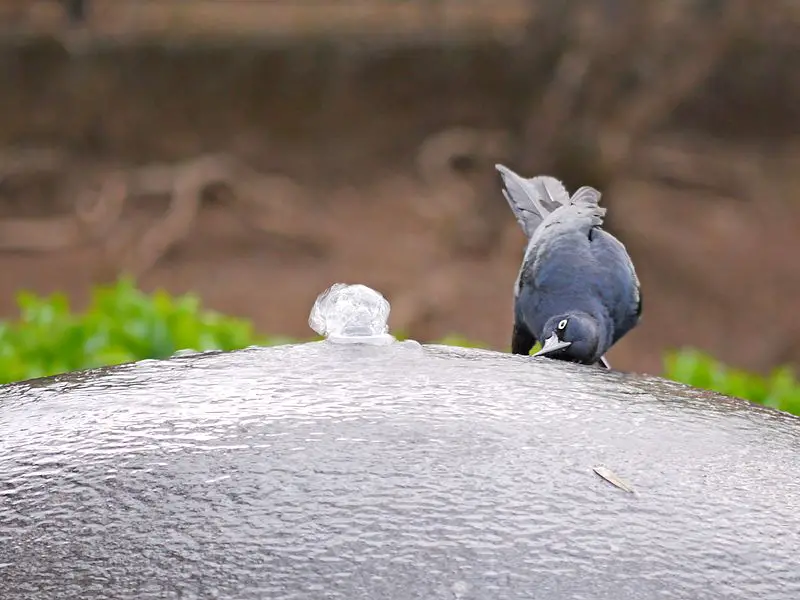
The Nicaraguan Grackle is a species of passerine bird native to Nicaragua and northernmost Costa Rica. It has an impressive physique, with a long graduated tail and relatively long bill and legs.
The male boasts lustrous black plumage whilst the female is grey-brown in colouration. Males also have yellow eyes, giving them a particularly striking appearance.
They are medium sized birds, usually measuring up to 30cm in length including their tails.
They inhabit open woodland areas where they feed on insects as well as fruits such as figs or bananas that may be available seasonally.
Despite being widespread across these two countries it remains vulnerable due to agricultural intensification which has caused habitat loss for this beautiful species of grackle.
Scientific classification:
| Kingdom | Animalia |
| Phylum | Chordata |
| Class | Aves |
| Order | Passeriformes |
| Family | Icteridae |
| Genus | Quiscalus |
| Species | Q. nicaraguensis |
15. Amazonian Motmot
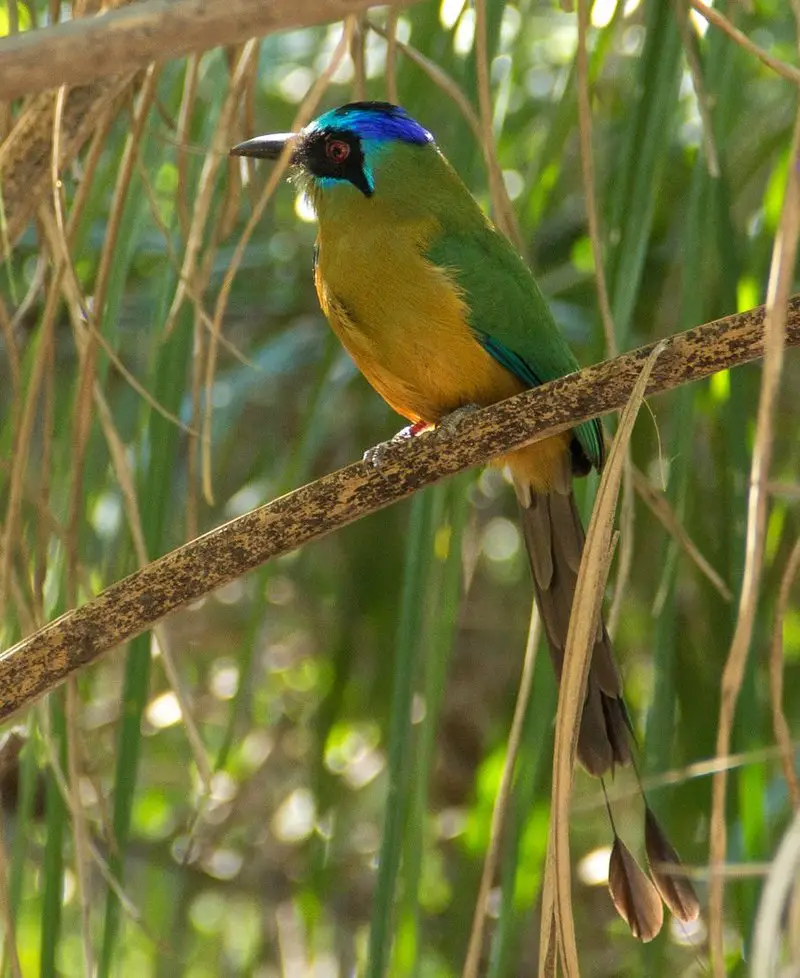
The Amazonian Motmot is a vibrant bird belonging to the family Momotidae. It can be found in lowland areas of South America, from Venezuela to Brazil and Argentina.
This colourful near-passerine has an impressive body length of up to 18 cm (7 inches) with striking green and blue plumage.
Its characteristic long tail tipped with two central feathers gives it a unique appearance that sets it apart from other birds in its region.
The diet consists mainly of insects, small reptiles or amphibians, as well as fruits and berries when available nearby.
As they are monogamous birds, males use their bright colours for display during courtship rituals which involve bowing displays and aerial acrobatics while chasing each other around tree branches.
Scientific classification:
| Kingdom | Animalia |
| Phylum | Chordata |
| Class | Aves |
| Order | Coraciiformes |
| Family | Momotidae |
| Genus | Momotus |
| Species | M. momota |
16. Spot-Breasted Oriole
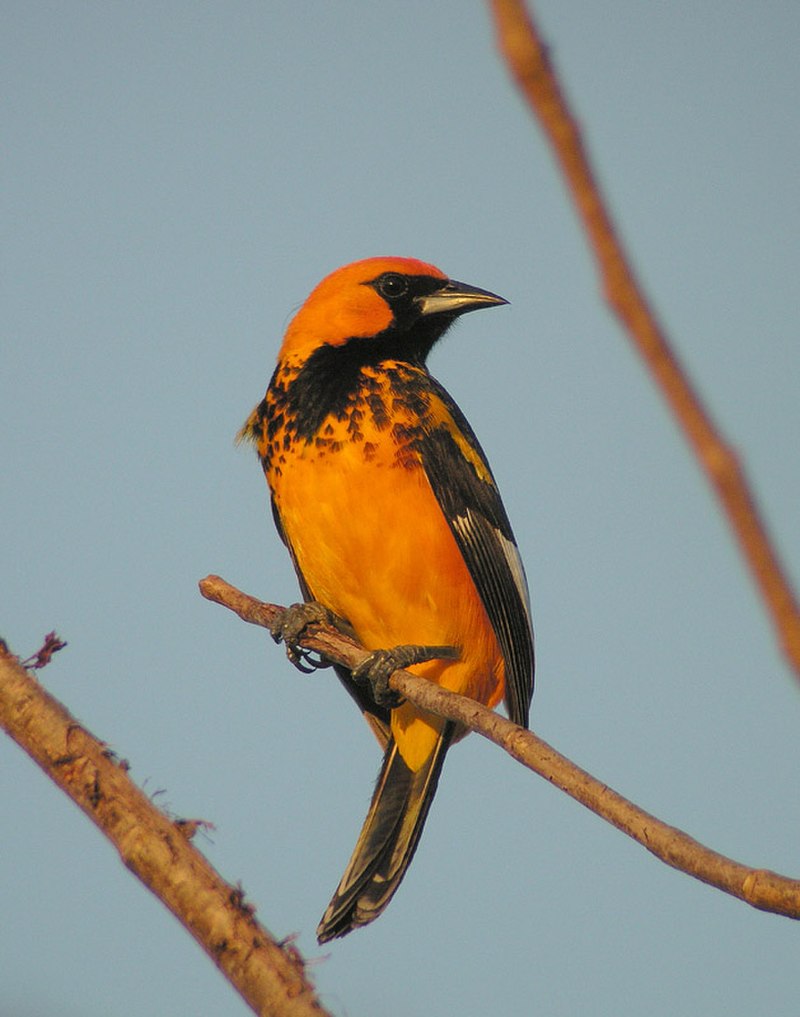
The Spot-breasted Oriole is a stunningly beautiful bird, with its bright orange feathers and black bib. It can be found in Central America from Mexico to Panama, including much of the Caribbean region.
The male and female share similar plumage; however, females are olive green on their back and tail instead of orange like males. Juveniles lack most or all of the black coloring on their face and throat too.
This mid-sized songbird loves open woodlands near water sources such as rivers or streams where it can feed off insects for sustenance. Its distinctive call also makes it easy to spot if you’re out looking for birds.
Scientific classification:
| Kingdom | Animalia |
| Phylum | Chordata |
| Class | Aves |
| Order | Passeriformes |
| Family | Icteridae |
| Genus | Icterus |
| Species | I. pectoralis |
Also Featured In: Yellow Birds that Live in Florida, Black Birds that Live around United States of America
17. Great Green Macaw
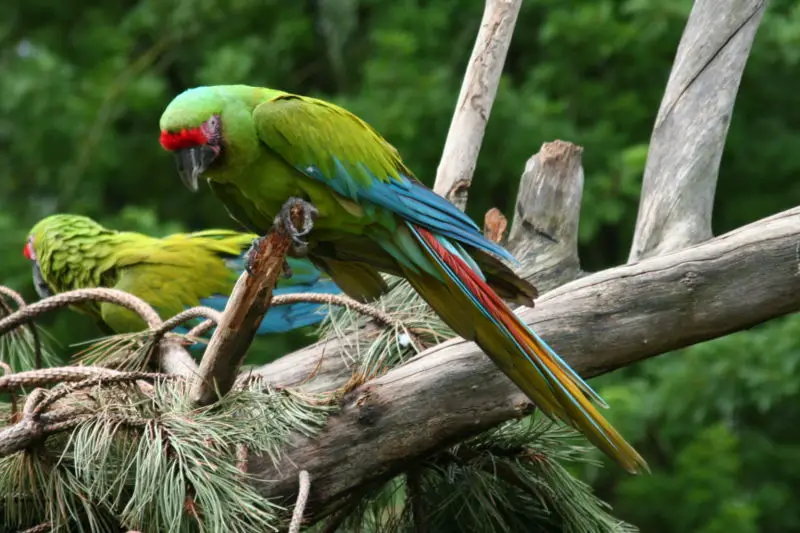
The great green macaw is a beautiful Central and South American parrot that can be found from Honduras to Colombia as well as Nicaragua, Costa Rica, Panama, and Ecuador.
With its bright red forehead, yellow cheeks and blue wings it’s easy to spot in the wild.
This magnificent bird has two recognized subspecies; Ara ambiguus ssp. ambiguus which ranges across most of its range while Ara ambiguus ssp. guayaquilensis appears exclusive to northwestern Ecuador.
These birds are usually seen foraging for seeds but their diet also includes fruits such as figs or palm nuts making them an important part of tropical ecosystems.
Scientific classification:
| Kingdom | Animalia |
| Phylum | Chordata |
| Class | Aves |
| Order | Psittaciformes |
| Family | Psittacidae |
| Genus | Ara |
| Species | A. ambiguus |
18. Violet Sabrewing
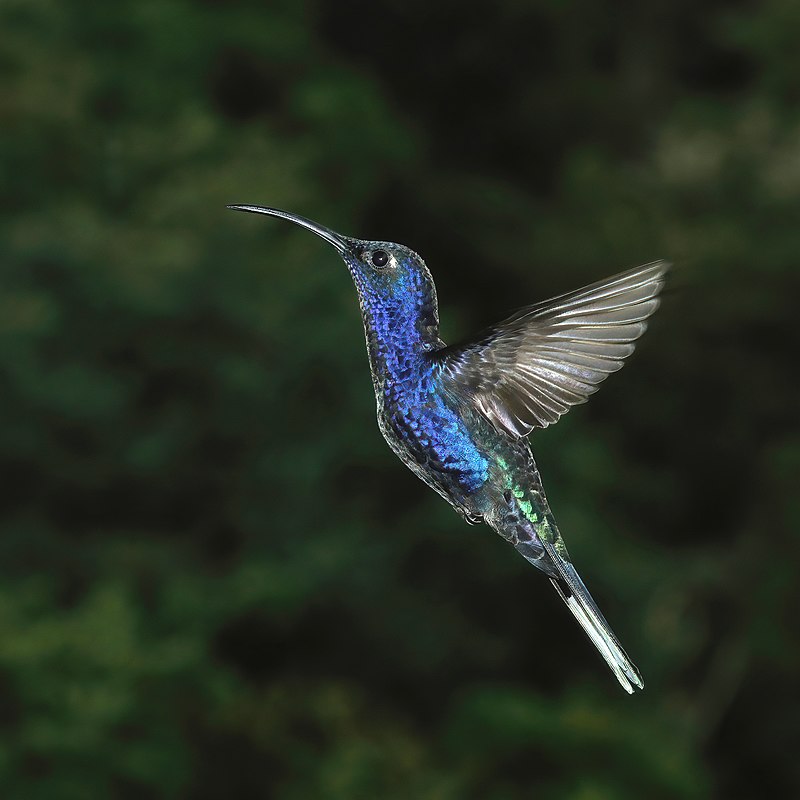
The Violet Sabrewing is the largest hummingbird in Mexico and Central America, with a length of 13-15cm (5.1 to 5.9in).
It belongs to the Trochilini tribe of Emeralds subfamily (Trochilinae), and has two distinct species – C. h. hemileucurus and C. h.. mellitus – found from Mexico to Panama.
This colorful bird typically sports an iridescent violet throat, shining green back, white breast as well as black head, tail feathers and beak tip; all adding up to its stunning beauty.
Its diet consists mainly nectar it collects from flowers by hovering around them like typical hummingbirds do but also feeds on small insects for much needed protein intake.
The Violet Sabrewing is known for their long migrations across great distances just so they can find suitable places where food sources are abundant during different seasons throughout the year.
Scientific classification:
| Kingdom | Animalia |
| Phylum | Chordata |
| Class | Aves |
| Order | Apodiformes |
| Family | Trochilidae |
| Genus | Campylopterus |
| Species | C. hemileucurus |
19. White-Necked Jacobin
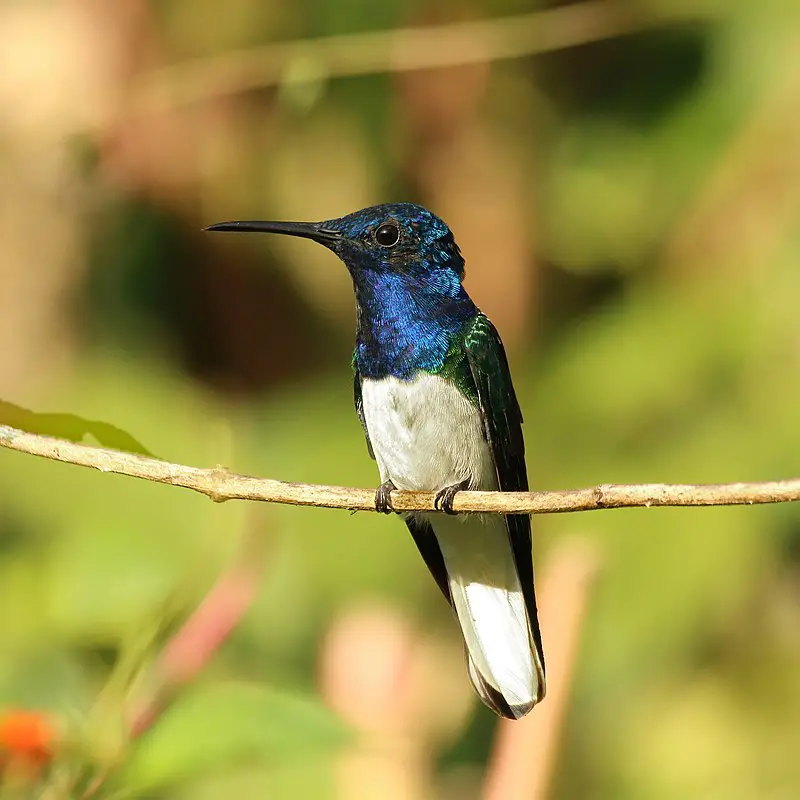
The White-necked Jacobin is a medium-sized hummingbird found throughout Central America, South America and Trinidad & Tobago. Its scientific name “Florisuga mellivora” translates to “honey loving flower hitter”.
It’s also known as the Great Jacobin or Collared Hummingbird due to its white neck collar which stands out against its glossy green upper parts and paler underside.
These birds are mainly nectar feeders but they have been known to eat some insects too.
They tend to inhabit open woodlands near water sources like streams, rivers and lakes where they can find their favorite food of nectar from flowers such as cacti, hibiscus shrubs and heliconias.
The males display an impressive courtship dance with wings whirring around in circles at high speed while singing loudly.
This unique species has captivated many nature lovers all over the world making it one of the most beloved hummingbirds on earth.
Scientific classification:
| Kingdom | Animalia |
| Phylum | Chordata |
| Class | Aves |
| Order | Apodiformes |
| Family | Trochilidae |
| Genus | Florisuga |
| Species | F. mellivora |
20. Lineated Woodpecker

The Lineated Woodpecker is a large bird found in Mexico, Argentina and the Caribbean. It was first described by French zoologist Mathurin Jacques Brisson in 1760 with the name Le pic noir.
This species has black upperparts, wings and tail with white stripes running along its back and head; it also features red marks on its forehead as well as on both sides of its neck.
Its underparts are mostly greyish-white while its bill is yellowish-black and slightly hooked at the end.
These birds feed mainly on insects but can sometimes be seen foraging for fruits or tree sap too.
They nest inside cavities usually made from dead trees which they excavate themselves using their strong bills perfect for drilling into woody material easily.
All in all, these beautiful birds make an interesting addition to any backyard garden.
Scientific classification:
| Kingdom | Animalia |
| Phylum | Chordata |
| Class | Aves |
| Order | Piciformes |
| Family | Picidae |
| Genus | Dryocopus |
| Species | D. lineatus |
21. Little Blue Heron
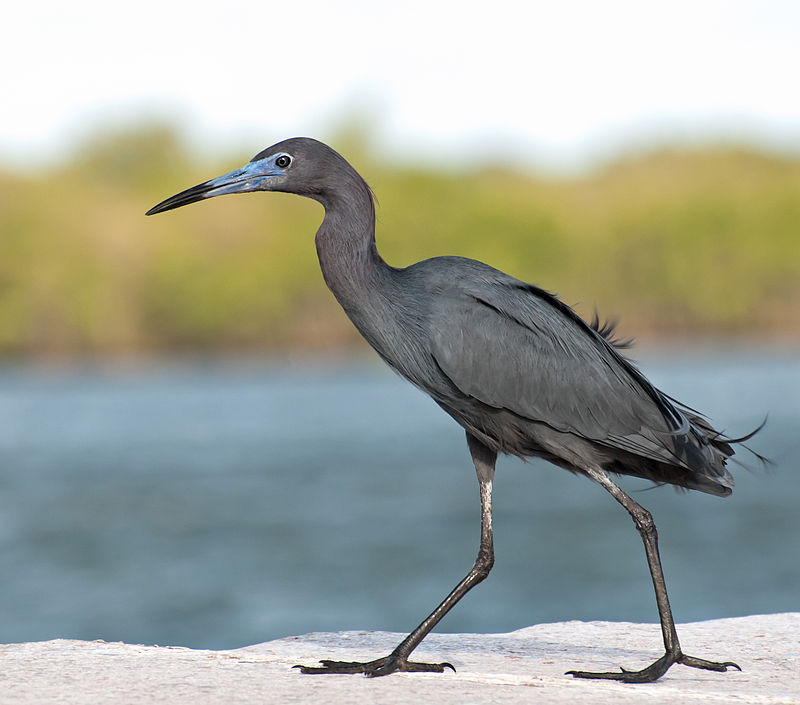
The Little Blue Heron is a small, darkly-colored heron with two-toned bill. Juveniles are completely white, similar to the Snowy Egret. In breeding season, adults develop unique coloration on their head and legs.
The bird has an expansive habitat range that covers much of the Americas from North America all the way down to South America.
They feed mostly in shallow water areas like tidal flats or marshes and eat small aquatic animals such as fish, frogs and crustaceans.
This species can also be found along coastal regions where they gather at night for roosting purposes during winter months when food sources become more scarce due to migration patterns of its prey animals.
These birds have adapted well over time allowing them to persist in most habitats throughout their wide range even despite environmental changes caused by human activities such as pollution or development projects near wetlands ecosystems which are essential for this species’ survival.
Scientific classification:
| Kingdom | Animalia |
| Phylum | Chordata |
| Class | Aves |
| Order | Pelecaniformes |
| Family | Ardeidae |
| Genus | Egretta |
| Species | E. caerulea |
22. Cinnamon Hummingbird
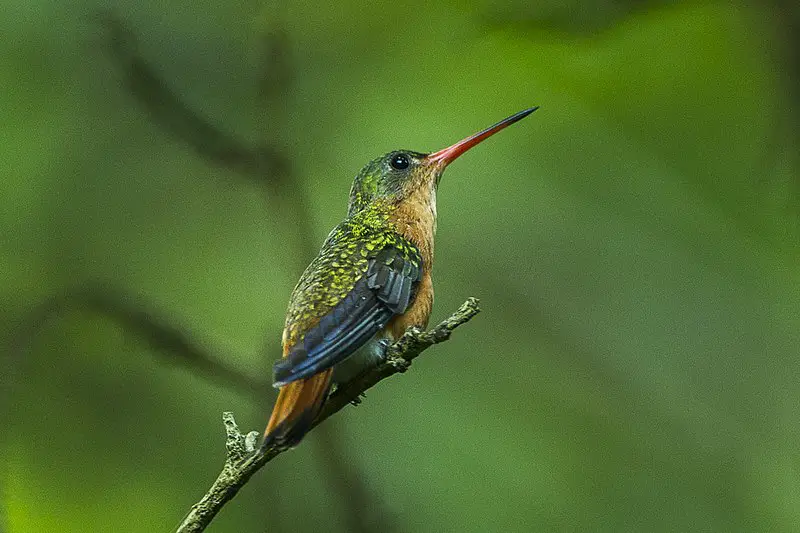
The Cinnamon Hummingbird is a species of hummingbird found in the ‘emeralds’, tribe Trochilini of subfamily Trochilinae.
It can be seen from Mexico to Costa Rica and was officially documented by French naturalist René Lesson in 1842 near Acapulco, Mexico.
The tiny bird measures around four inches long and has a bright metallic green back with orange-brown on its throat, chest and belly. Its wings are short but strong enough for them to beat up to 80 times per second.
They feed mainly on nectar from flowers as well as small insects such as spiders or ants which they capture mid-flight.
These birds have adapted perfectly for life among flowering plants; their curved bills enable them to reach deep into flowers while their tongues help suck out sweet nectar quickly so that they can move onto the next flower.
Scientific classification:
| Kingdom | Animalia |
| Phylum | Chordata |
| Class | Aves |
| Order | Apodiformes |
| Family | Trochilidae |
| Genus | Amazilia |
| Species | A. rutila |
23. Canivet’s Emerald
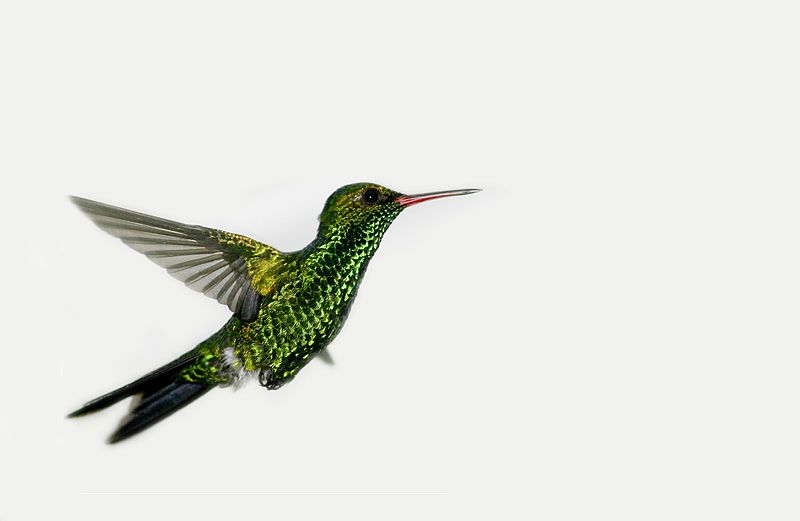
Canivet’s emerald is a mesmerizing hummingbird found in Belize, Costa Rica, El Salvador, Guatemala, Honduras, Mexico and Nicaragua. It belongs to the Trochilini tribe of subfamily Trochilinae which are also known as ‘emeralds’.
This species has had an interesting taxonomic history with its name being changed several times before finally settling on Canivet’s emerald currently.
Its bright colors make it quite attractive and easy to spot amongst other birds due to its unique plumage pattern that prominently features greenish-blue hues.
As this bird mostly feeds on nectar from flowers while hovering near them they have become associated with beauty when mentioned in literature or folklore throughout their native range making it quite popular among people interested in ornithology or nature photography.
Scientific classification:
| Kingdom | Animalia |
| Phylum | Chordata |
| Class | Aves |
| Order | Apodiformes |
| Family | Trochilidae |
| Genus | Cynanthus |
| Species | C. canivetii |
24. Northern Jacana
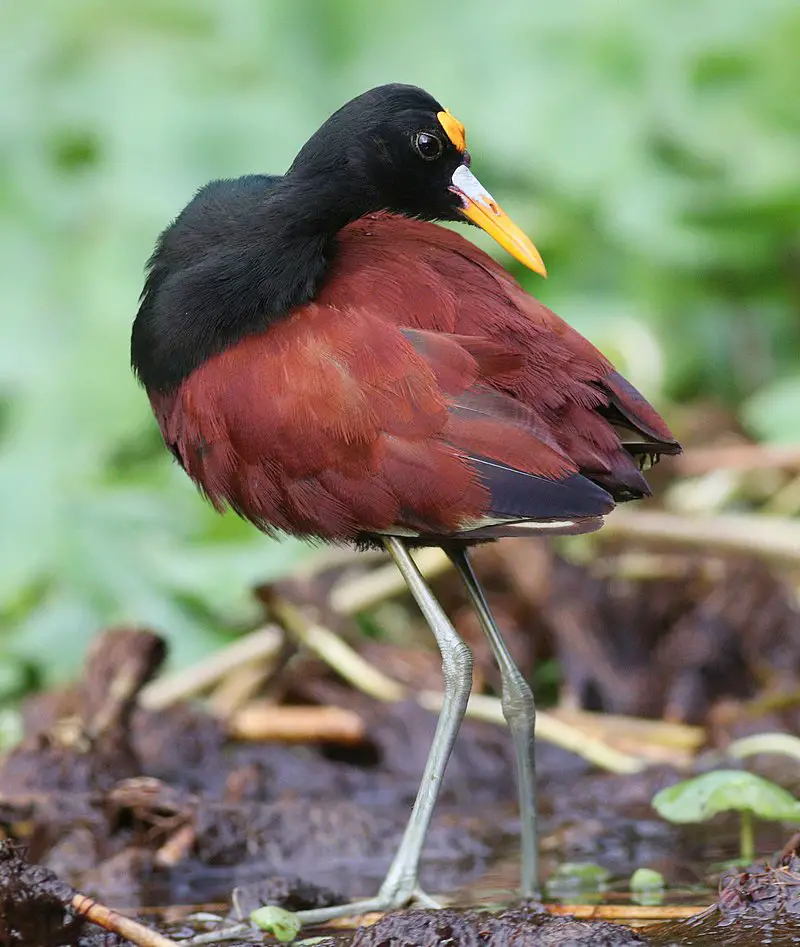
The Northern Jacana is a wading bird native to Mexico, Panama, Cuba, Jamaica and Hispaniola. It can also be found in Texas as a resident breeder or on rare occasions in Arizona as a vagrant.
This species of wetland birds are easily identified by their immense size and large feet with long toes that help them walk atop floating vegetation while searching for food.
Their upperparts have black feathers streaked with white whilst its underparts display brown plumage marked by yellowish spots near the wingtips.
They feed primarily on insects but will also eat other aquatic invertebrates like crustaceans or mollusks when available.
The female builds an untidy nest made from leaves close to water so she can quickly escape predators if needed.
Scientific classification:
| Kingdom | Animalia |
| Phylum | Chordata |
| Class | Aves |
| Order | Charadriiformes |
| Family | Jacanidae |
| Genus | Jacana |
| Species | J. spinosa |
25. Laughing Falcon
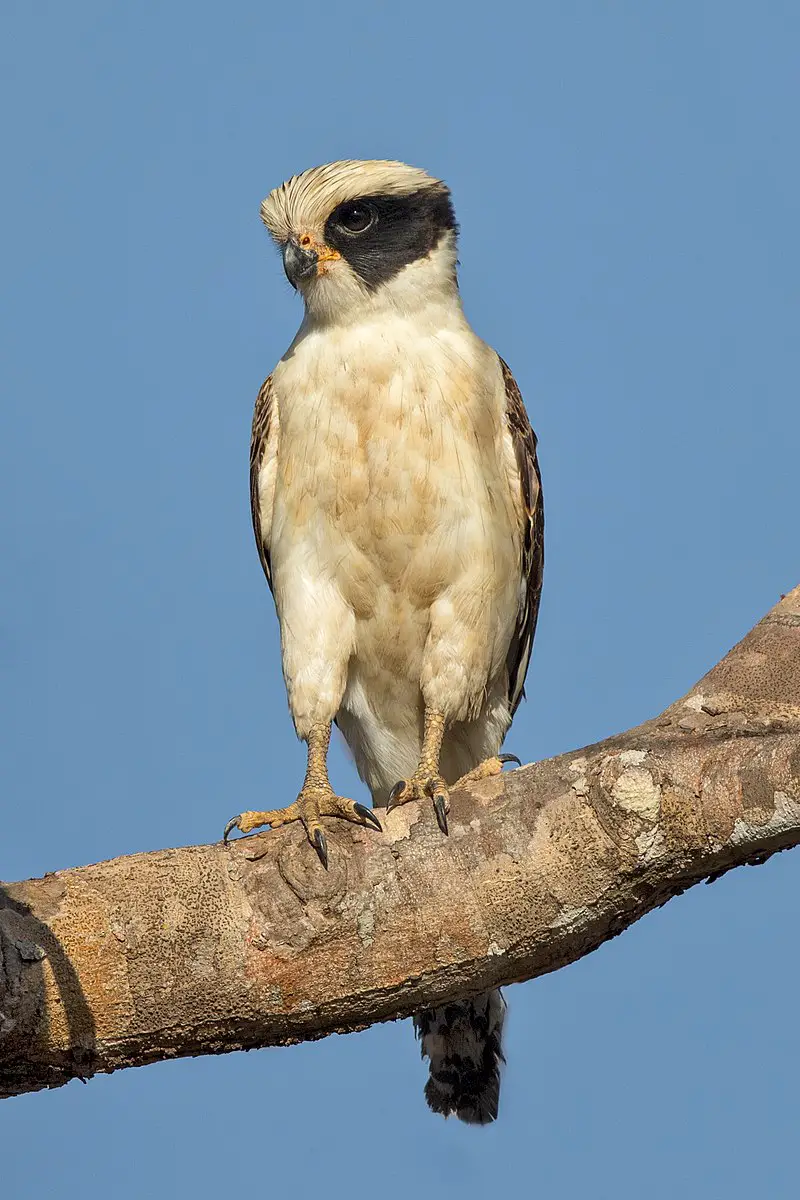
The Laughing Falcon is a medium-sized bird of prey belonging to the falcon family. It’s only member of its genus, Herpetotheres cachinnans, and got its name from it’s distinct loud voice.
This Neotropical species is known for being an expert snake eater. With sharp talons and powerful beak they are well equipped for hunting down snakes and lizards with ease.
Despite their fierce reputation they have a gentle side too; pairs usually mate for life while looking after their offspring together in harmony.
The Laughing Falcon should be admired rather than feared as this amazing creature has much more to offer than just hissing sound effects.
Scientific classification:
| Kingdom | Animalia |
| Phylum | Chordata |
| Class | Aves |
| Order | Falconiformes |
| Family | Falconidae |
| Subfamily | Herpetotherinae |
| Genus | Herpetotheres Vieillot, 1817 |
| Species | H. cachinnans |
Also Featured In: Most Common Oaxaca Birds,
26. Bare-Throated Tiger Heron
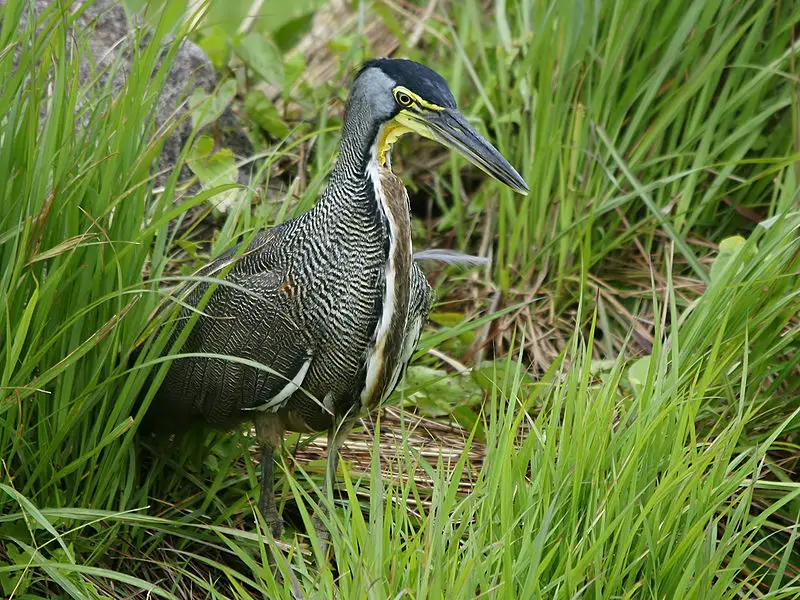
The Bare-throated Tiger Heron is an impressive wading bird belonging to the heron family, Ardeidae.
It has a length of 80 cm and weighs 1,200 grams. Found from Mexico to northwestern Colombia with one recorded sighting from the United States in Texas, it prefers more open habitats such as river and lake banks than other Tigrisoma herons.
Its plumage is blackish above with white spots on its back while its lower parts are chestnut brown or rufous in coloration.
The head and throat have bare yellow skin that can turn bright red when alarmed or during courtship displays.
Additionally, these birds feed mainly on fish but also eat amphibians, reptiles and aquatic insects which they capture by standing still before suddenly snatching them up.
Scientific classification:
| Kingdom | Animalia |
| Phylum | Chordata |
| Class | Aves |
| Order | Pelecaniformes |
| Family | Ardeidae |
| Genus | Tigrisoma |
| Species | T. mexicanum |
Also Featured In: Puerto Vallarta Birds You Should Know, Most Common Birds You’ll Find in Quintana Roo
27. White-Crowned Parrot
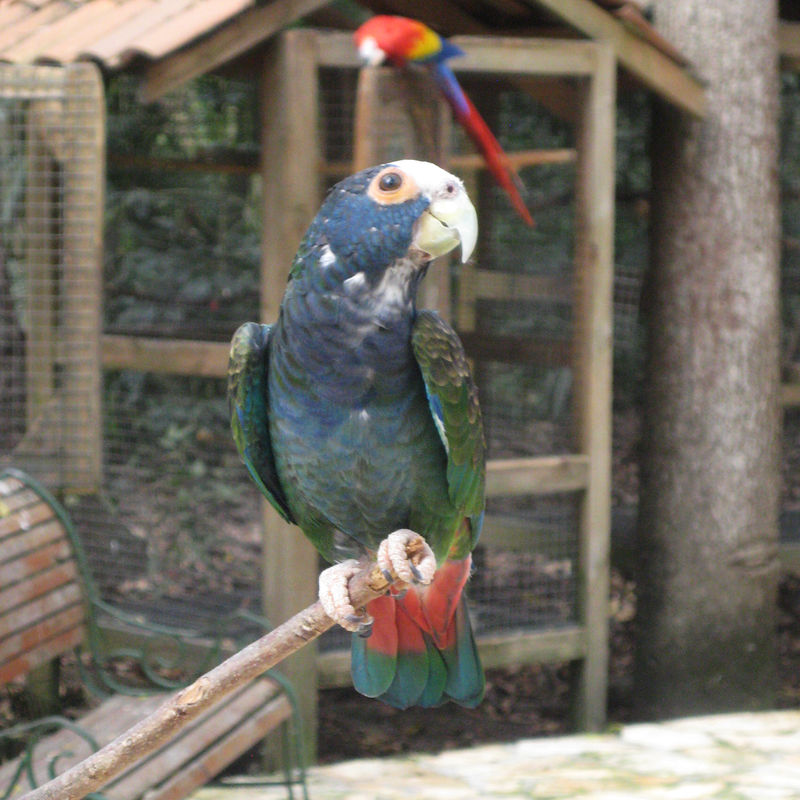
The white-crowned parrot is found in the lowlands of Mexico to western Panama. It loves living among forest canopies and edges, as well as semi-open woodland and second growth areas.
These birds have a stunning appearance with their green plumage, blue wings, and red tail feathers being topped off by a beautiful white crown on their heads.
They lay 3 to 6 eggs in an unlined nest often built within tree cavities or hollows.
The male plays an active role during mating season by helping build the nest structure while also providing food for his mate throughout incubation period of 25 days before they hatch into cute little chicks.
All in all, this species makes for a wonderful sight due to its unique colouration that truly stands out from other parrots.
Scientific classification:
| Kingdom | Animalia |
| Phylum | Chordata |
| Class | Aves |
| Order | Psittaciformes |
| Family | Psittacidae |
| Genus | Pionus |
| Species | P. senilis |
28. Mountain Elaenia
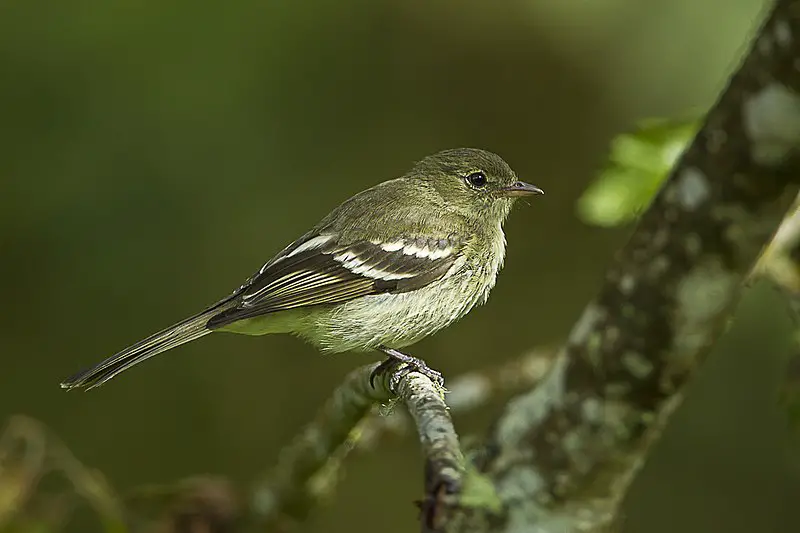
The Mountain Elaenia is a small yet beautiful bird belonging to the Tyrant Flycatcher family. It lives in highland areas from Guatemala to Colombia and western Venezuela, with its scientific name honoring German physician and naturalist Alexander von Frantzius.
This avian measures around 14-15 cm long, weighing 17-20 gm. Its upperparts are olive colored while wings feature two white bars which contrast against the dark feathers of its head making it unique looking bird.
The underparts are yellowish green or light gray along with a short tail containing faint barring pattern on them.
During breeding season these birds sing their distinct song consisting of several harsh notes ending abruptly giving an impression that they stopped singing suddenly mid way.
They feed mainly on insects but also eat some fruits as well when available during winter months.
Scientific classification:
| Kingdom | Animalia |
| Phylum | Chordata |
| Class | Aves |
| Order | Passeriformes |
| Family | Tyrannidae |
| Genus | Elaenia |
| Species | E. frantzii |
29. Jacanas
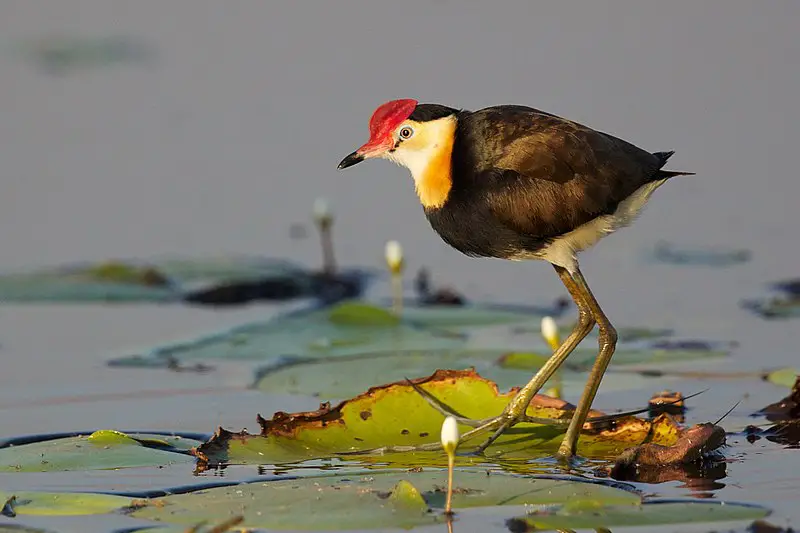
Jacanas are tropical waders belonging to the Jacanidae family. They have distinctive elongated toes and toenails which help them forage on floating or semi-emergent aquatic vegetation.
This adaptation gives them their nickname “Jesus birds” as they seem to be able to walk on water.
The female jacanas are also unique amongst bird species in that they take charge of nest building, incubation and caring for young while males perform courtship displays.
These unusual birds can be found throughout the world’s tropical regions where they inhabit wetlands such as swamps, marshes and shallow lakes with lily pads.
With a wide variety range due their special adaptations these beautiful creatures will surely continue living life at ease around our planet’s warmest waters.
Scientific classification:
| Kingdom | Animalia |
| Phylum | Chordata |
| Class | Aves |
| Order | Charadriiformes |
| Suborder | Thinocori |
| Family | Jacanidae Stejneger, 1885 |
30. Stone-Curlew

Stone-curlews, also known as dikkops or thick-knees, are a family of birds that have adapted to live in tropical and temperate regions throughout the world.
They can be found in Africa, Asia and Australia with two or more species per region. Despite being classified as waders, most prefer dry arid habitats over moist wetlands.
Stone-curlews typically have long legs which help them navigate through their preferred terrain efficiently; some species even stand at an impressive height when standing on those long legs.
Additionally they feature cryptic plumage which helps them blend into their surroundings while hunting for prey such as insects and small mammals like rodents.
These unique bird’s calls are easily recognizable; it has been said that hearing one is similar to listening to someone whistling ‘Keee Weee’.
Scientific classification:
| Kingdom | Animalia |
| Phylum | Chordata |
| Class | Aves |
| Order | Charadriiformes |
| Suborder | Chionidi |
| Family | Burhinidae Mathews, 1912 |
31. Threskiornithidae
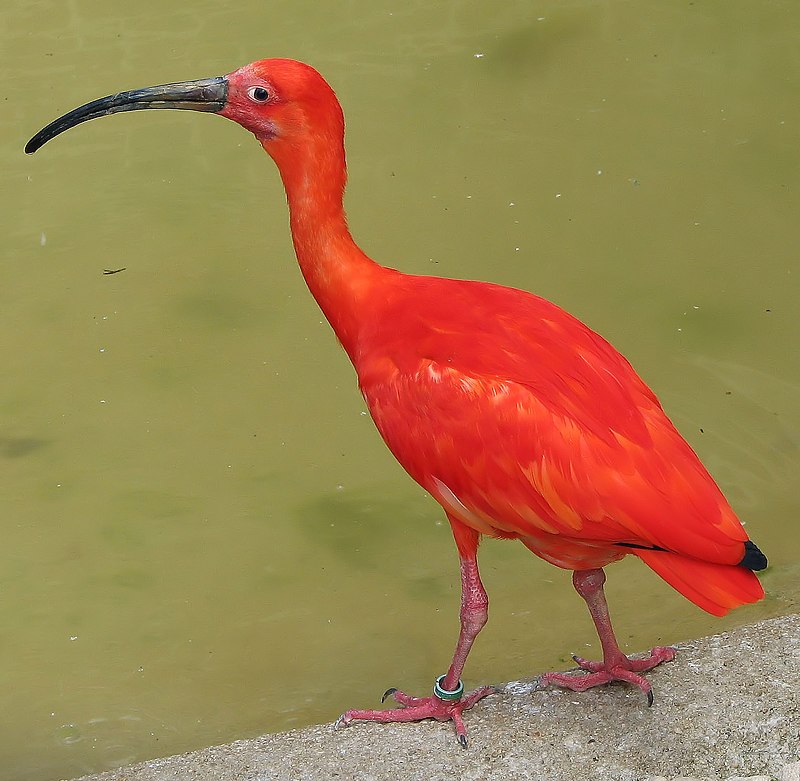
Threskiornithidae is a family of large wading birds which includes 36 species. These birds are traditionally divided into two subfamilies – the ibises and the spoonbills.
However, recent genetic analysis has shown that spoonbills actually belong to Old World ibis group, while New World ibises form an early offshoot from this lineage.
Threskiornithidse members have long curved beaks with serrated edges used for catching fish in shallow water or mudflats, as well as other aquatic invertebrates like crustaceans and mollusks.
They also feed on plant matter such as grains and seeds found close to wetlands areas where they live.
This diverse diet makes them important scavengers in their ecosystems, helping maintain healthy populations of native wildlife by controlling insect numbers and dispersing energy-rich seeds throughout wetland habitats.
Scientific classification:
| Kingdom | Animalia |
| Phylum | Chordata |
| Class | Aves |
| Order | Pelecaniformes |
| Suborder | Ardei |
| Family | Threskiornithidae Richmond, 1917 |
32. Heliornithidae
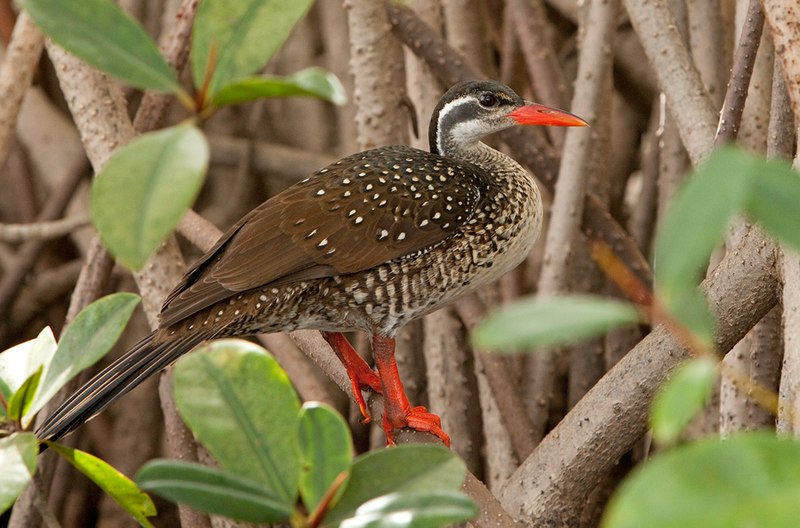
Heliornithidae, commonly known as finfoots, are a small family of tropical birds found in South America and Africa. They have webbed feet like grebes or coots, long necks, slender bodies and broad tails with sharp pointed bills.
Their diverse calls include whistles, squawks and croaks which they use to communicate with each other.
Finfoots feed mainly on fish but also consume insects such as water beetles and dragonflies near the surface of waterbodies.
They nest around rivers or lakes where there is plenty of cover from predators such as eagles or hawks.
During breeding season males can become quite territorial defending their territories against intruders by chasing them off aggressively using loud noises or even physical contact if necessary.
Scientific classification:
| Kingdom | Animalia |
| Phylum | Chordata |
| Class | Aves |
| Order | Gruiformes |
| Family | Heliornithidae GR Gray, 1840 |
33. Procellariidae

Procellariidae is a diverse family of seabirds belonging to the bird order Procellariiformes.
These birds are commonly referred to as tubenoses and include fulmarine petrels, gadfly petrels, diving petrels, prions, and shearwaters.
They range in size from the small storm-petrel which measures around 18cm long to the giant albatross which can reach up to 3 meters in length.
Generally found near oceans or coasts where they feed on fish as well as squid and other marine life depending on species.
Many procellariids will also nest inland during breeding season before returning back out at sea for most of their lives.
Their wings have specially adapted feathers that give them incredible gliding abilities allowing them literally fly with minimal effort over vast distances across oceanic regions.
Scientific classification:
| Kingdom | Animalia |
| Phylum | Chordata |
| Class | Aves |
| Order | Procellariiformes |
| Family | Procellariidae Leach, 1820 |
34. New World Quail
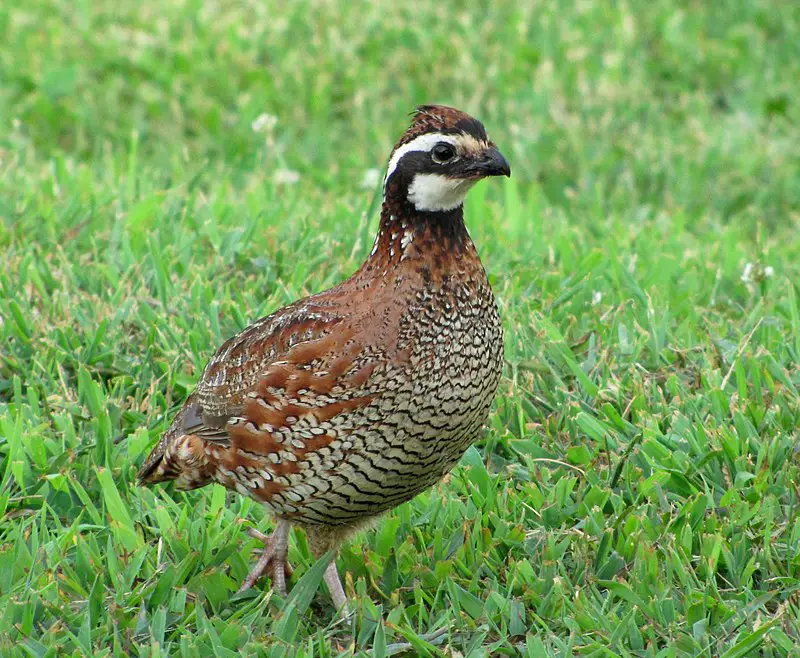
New World quail are small birds found in the Americas, from Canada to Brazil. They belong to their own family, Odontophoridae, and have similar appearance and habits as Old World quail which belong to a different family.
New World Quails come in various species such as California Quail and Bobwhite Quail.
These birds have adapted well to human presence due to availability of food resources like agricultural crops.
They also live close together where they form large flocks for safety against predators like foxes or hawks.
The males usually sport colorful feathers during mating season that helps them attract female mates while providing an amazing sight for us viewers.
Scientific classification:
| Kingdom | Animalia |
| Phylum | Chordata |
| Class | Aves |
| Order | Galliformes |
| Superfamily | Phasianoidea |
| Family | Odontophoridae Gould, 1844 |
35. Jacamars
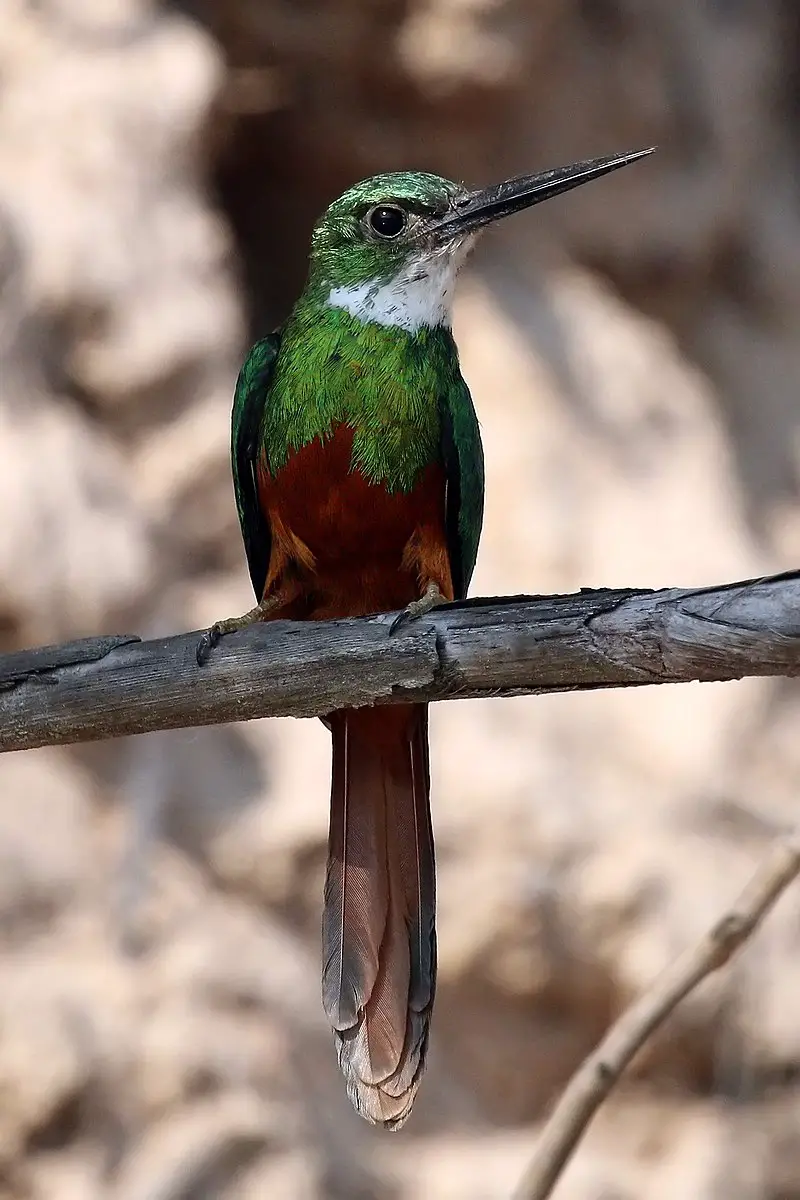
Jacamars are tropical birds native to South and Central America, extending as far north as Mexico. They belong to the Galbulidae family which consists of five genera and eighteen species in total.
These captivating birds can be easily distinguished by their unique appearance; they have long sharp bills with bright vivid plumage ranging from blues, greens and yellows that create a beautiful contrast against the lush vegetation of their natural habitat.
Jacamars prefer to inhabit dense forested areas near rivers or streams where they use their agile wings for quick flight maneuvers while hunting insects, lizards and frogs.
With an unmistakable presence these fascinating feathered creatures make a remarkable addition to any backyard bird sanctuary.
Scientific classification:
| Kingdom | Animalia |
| Phylum | Chordata |
| Class | Aves |
| Order | Piciformes |
| Suborder | Galbuli |
| Family | Galbulidae Vigors, 1825 |
36. Stilts And Avocets
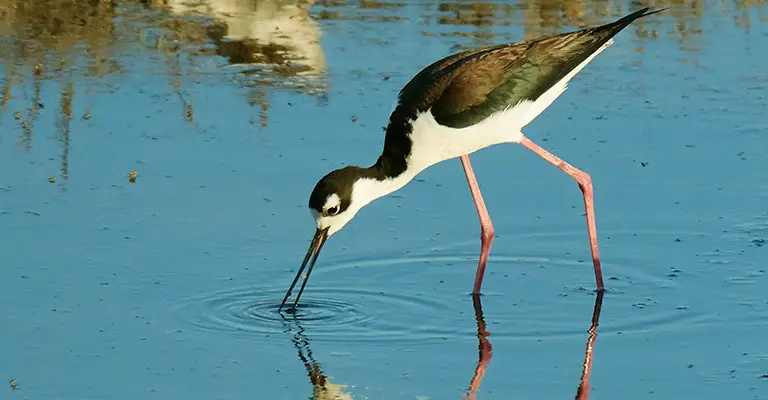
Stilts and avocets are two distinct groups of birds belonging to the family Recurvirostridae. They range in length from 30-46 cm (12-18 inches) and weigh between 140 – 435 g (4.9 – 15.3 ounces).
Males usually have slightly larger bodies than females, with long thin legs, necks and bills.
Avocet bills curve upwards uniquely while stilt beaks remain straight most times.
These wading birds live mainly near shorelines or wetlands where they feed on aquatic invertebrates like brine shrimp, insects etc., occasionally supplementing their diet with seeds or small fish too.
Stilts also inhabit open fields in search of food sources such as earthworms or grasshoppers during the non-breeding season.
Both groups migrate over large distances for warmer weathers when it gets cold outside.
Scientific classification:
| Kingdom | Animalia |
| Phylum | Chordata |
| Class | Aves |
| Order | Charadriiformes |
| Suborder | Charadrii |
| Family | Recurvirostridae Bonaparte, 1854 |
37. Antpitta
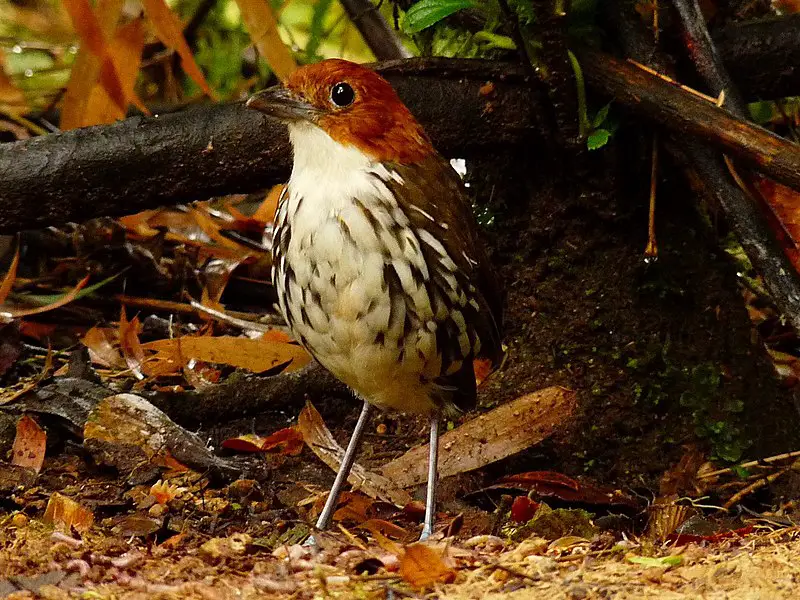
Antpittas are small passerine birds found in Central and South America. They measure 10-20 cm (4-8 inches) in length, making them some of the smallest members of their family Grallariidae.
These birds have a close relationship with both antbirds and gnateaters, which they were formerly placed alongside within the Formicariidae group.
Antpittas typically inhabit subtropical to tropical climates located near streams or other body water sources like rivers, ponds etc., where they forage for food on land but also take occasional dips into nearby bodies of water if needed.
In North America there is one species known as Ochthoeca frontalis which mainly inhabits Mexico’s western mountain ridge regions from Jalisco to Sonora states.
Scientific classification:
| Kingdom | Animalia |
| Phylum | Chordata |
| Class | Aves |
| Order | Passeriformes |
| Infraorder | Tyrannides |
| Parvorder | Furnariida |
| Family | Grallariidae P.L. Sclater and Salvin[1], 1873 |
38. Mangrove Swallow
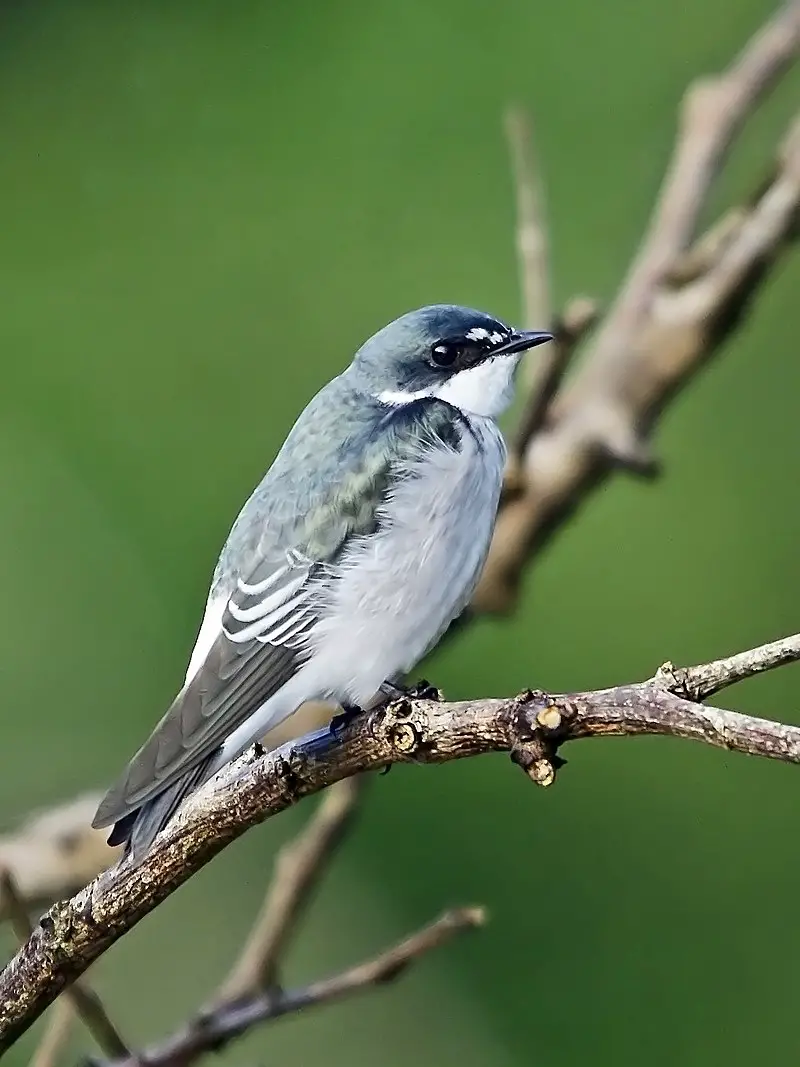
The Mangrove Swallow is a gorgeous bird that can be seen along coasts from Mexico to Panama.
It has bright blue-green upperparts, blackish flight feathers and a white rump, with the standout feature being its supraloral white streak – a line near its eye which only occurs in two other species of Tachycineta.
This swallow is often found flying around mangroves where it feeds on insects such as flies, wasps and beetles during the day and perches for roosting at night.
They nest in colonies close to each other under eaves or overhangs of buildings and tree hollows lined with mud pellets they create themselves.
The Mangrove Swallow makes an important contribution to our ecosystems by providing natural pest control services while adding beauty to coastal areas throughout Central America.
Scientific classification:
| Kingdom | Animalia |
| Phylum | Chordata |
| Class | Aves |
| Order | Passeriformes |
| Family | Hirundinidae |
| Genus | Tachycineta |
| Species | T. albilinea |
Also Featured In: Cozumel Birds You Didn’t Know,
39. Band-Tailed Barbthroat
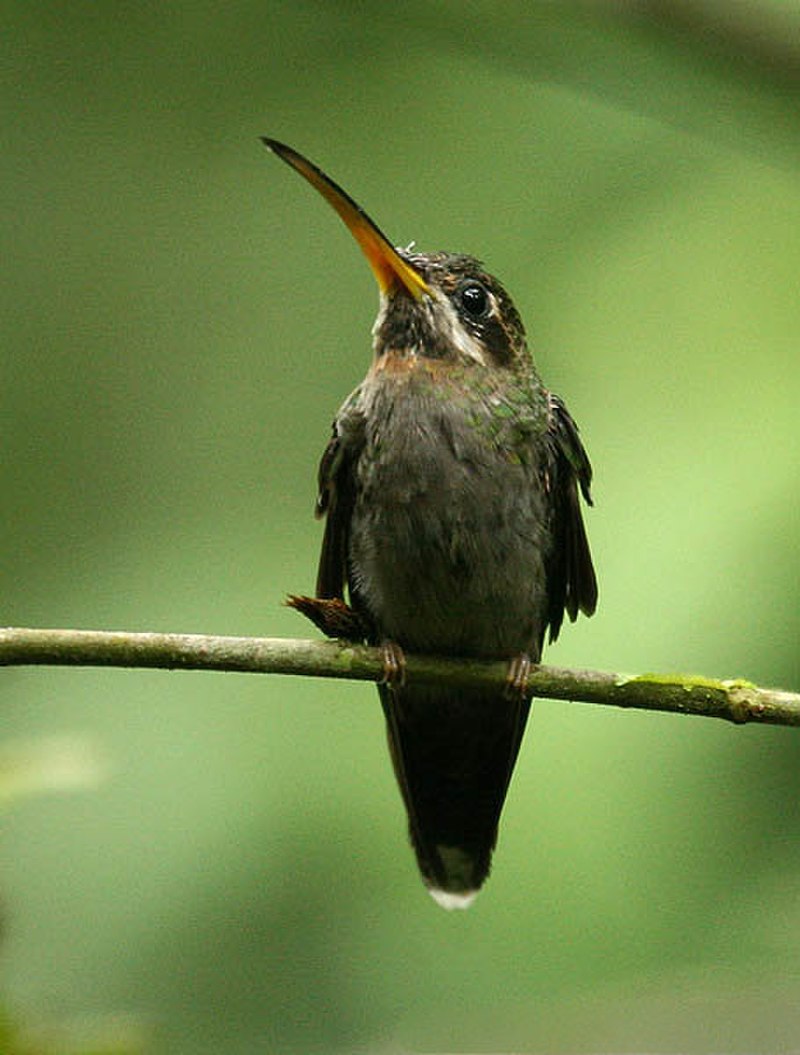
The Band-tailed Barbthroat is a medium sized hummingbird found in Central and South America. Its habitat ranges from southeastern Guatemala to western Venezuela, making it widespread throughout the region.
The bird has three recognized subspecies: T. ruckeri, T. hypostictus, and T. cinereicauda, as well as a fourth proposed subspecies of the Panama-Colombia border area known as darienensis that shares characteristics with all three others species of this bird family.
This unique looking creature has an emerald green back that fades into white towards its tail feathers which are tipped with black bands giving them their name ‘Band-tailed’. T
hey also have small yellow spots on their cheeks and throat along with distinctive pale brown tips at the end of each feather giving them a stunning complexity when displayed fully during flight or perched on tree branches for rest or searching for food like nectar from flowers or insects caught midair.
Scientific classification:
| Kingdom | Animalia |
| Phylum | Chordata |
| Class | Aves |
| Order | Apodiformes |
| Family | Trochilidae |
| Genus | Threnetes |
| Species | T. ruckeri |
40. Pale-Billed Woodpecker
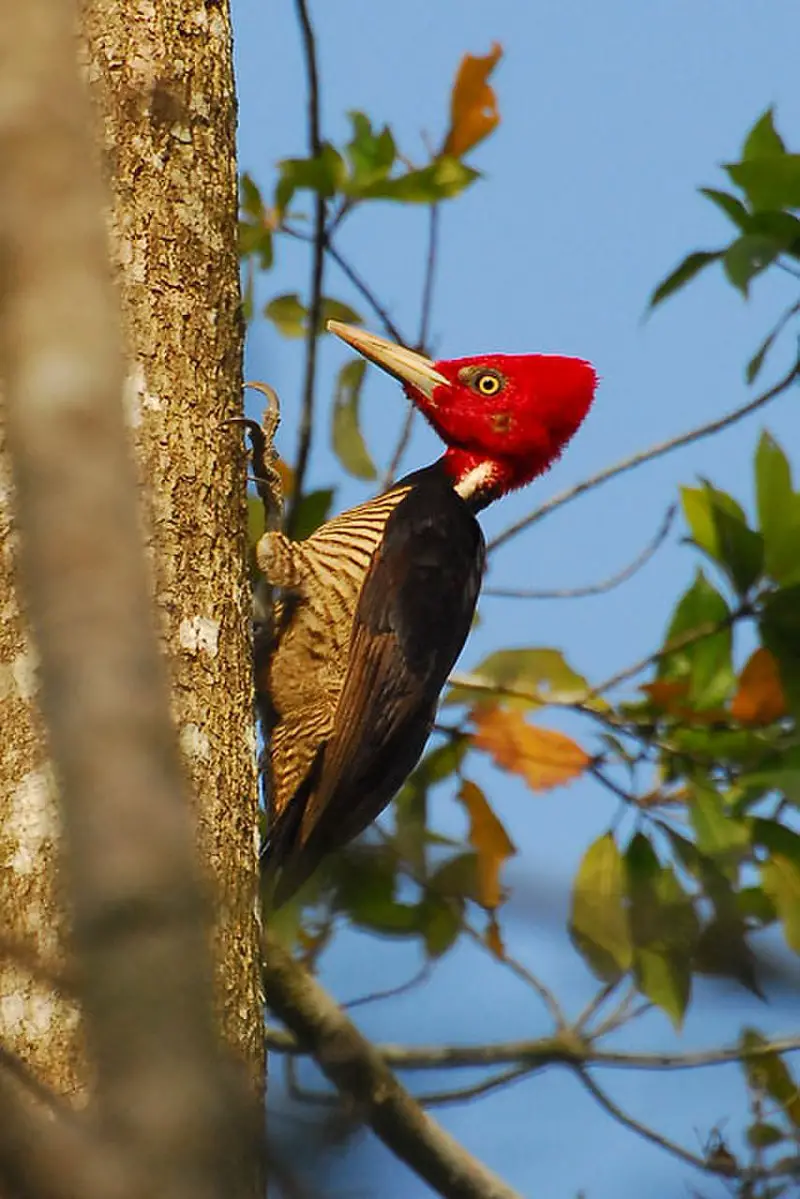
The Pale-billed woodpecker is a large, striking bird found in the tropical regions of Mexico to western Panama. It has an impressive size of 37 cm and weighs 255 g.
Its colouring consists mainly black plumage with white lines down its shoulders and a bushy crest on top. The most distinctive feature however is its pale bill which gives it its name.
This bird feeds mostly on dead or injured trees by pecking out insects from within them while they search for food in small groups or pairs. They are also known to feed on fruits, nuts, seeds and occasionally carrion too.
A truly remarkable species that adds beauty to the skies when flying around looking for their next meal.
Scientific classification:
| Kingdom | Animalia |
| Phylum | Chordata |
| Class | Aves |
| Order | Piciformes |
| Family | Picidae |
| Genus | Campephilus |
| Species | C. guatemalensis |
Also Featured In: Most Common Birds Found in Nayarit,
41. Puffbird
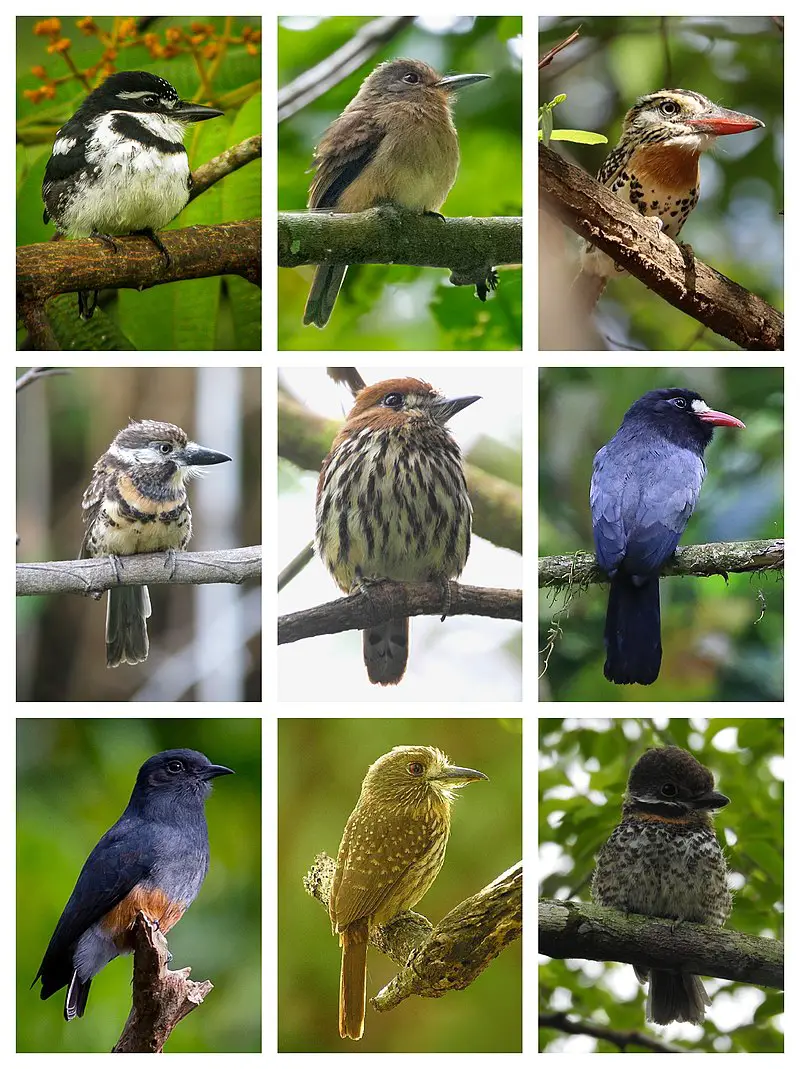
The Puffbird is a tropical tree-dwelling bird found in South America, Mexico and Central America.
It belongs to the near passerine family Bucconidae, which also includes jacamars – its closest relatives.
The order Piciformes unites these two families although some consider them separate under Galbuliformes.
Unlike other birds of the same group that have dazzling iridescent feathers, puffbirds are more modestly coloured with their greyish brown plumage blending into their environment for camouflage purposes when perched on trees or shrubs searching for insects as food sources using their long pointed bill.
They can be quite difficult to spot due to being small and well camouflaged but they may give away their presence by calling out loudly with an unmistakable whistling sound.
Scientific classification:
| Kingdom | Animalia |
| Phylum | Chordata |
| Class | Aves |
| Order | Piciformes |
| Suborder | Galbuli |
| Family | Bucconidae Horsfield, 1821 |
42. Blue Dacnis
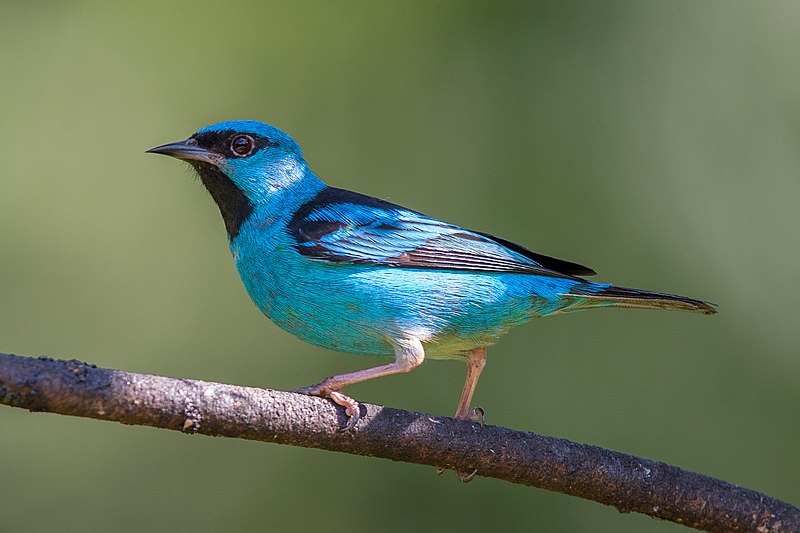
The Blue Dacnis or Turquoise Honeycreeper is a small, beautiful passerine bird found in Central and South America.
It belongs to the tanager family and has varying shades of blue plumage with black wings, tail feathers, beak and feet.
Native to Nicaragua, Panama, Trinidad and Bolivia to northern Argentina; it can often be seen in its natural habitat where it forages for food on shrubs near riversides.
The Blue Dacnis has an affinity towards fruit trees such as figs from which they feed on their nectar-rich flowers.
They have been known to form large flocks when travelling long distances during migration season making them easily recognizable in open areas like wetlands or grasslands while singing loudly with their melodic calls that resemble chirps of other birds.
Scientific classification:
| Kingdom | Animalia |
| Phylum | Chordata |
| Class | Aves |
| Order | Passeriformes |
| Family | Thraupidae |
| Genus | Dacnis |
| Species | D. cayana |
43. Stripe-Throated Hermit
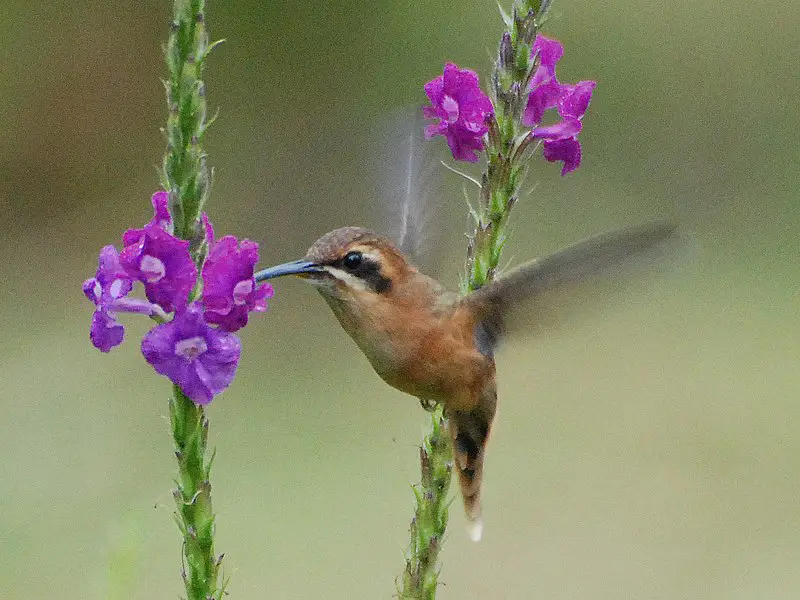
The Stripe-throated Hermit is a species of hummingbird found in Central America and north-western South America. It has dull wing coverts, mantle, nape and crown.
Its body length ranges from 9 to 10 cm with a weight of 2 to 3 grams making it one among the smaller hermits out there.
Despite its small size this species is considered quite common by BirdLife International who have assessed it as Least Concern on their Red List category for threatened birds due to their population being stable overall.
As they are relatively hardy birds they can be seen near forest edges or even backyards visiting flowers frequently during the day while staying hidden away at night roosting inside tree hollows or dense shrubs where they stay safe from potential predators like snakes an other large animals looking for easy prey.
Scientific classification:
| Kingdom | Animalia |
| Phylum | Chordata |
| Class | Aves |
| Order | Apodiformes |
| Family | Trochilidae |
| Genus | Phaethornis |
| Species | P. striigularis |
44. White-Necked Puffbird
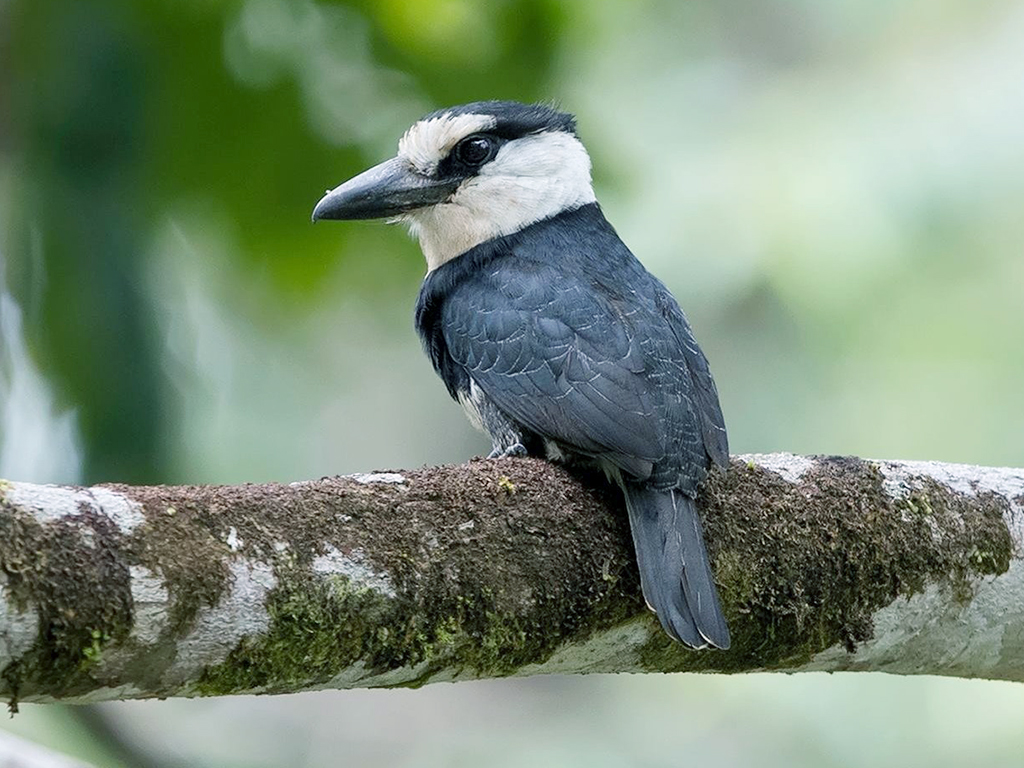
The White-necked Puffbird is a species of bird belonging to the Bucconidae family, found in Mexico, Central America, Bolivia and various other parts of South America.
It has white feathers on its neck which distinguishes it from the Buff-bellied Puffbird and Guianan Puffbird. It can also be identified by its large bill with hooked tip and prominent yellow eyes.
The adult plumage consists largely of greyish brown upperparts fading into pale buff underparts while juveniles are much duller than adults.
These birds prefer tropical lowland forests where they roost in trees or bushes before flying out occasionally during the day to feed on insects such as beetles, grasshoppers and caterpillars that they catch using their long bills.
They make loud calls consisting mostly of whistles though may also utter more complex vocalizations including mimicry at times too.
Scientific classification:
| Kingdom | Animalia |
| Phylum | Chordata |
| Class | Aves |
| Order | Piciformes |
| Family | Bucconidae |
| Genus | Notharchus |
| Species | N. hyperrhynchus |
45. Long-Tailed Manakin
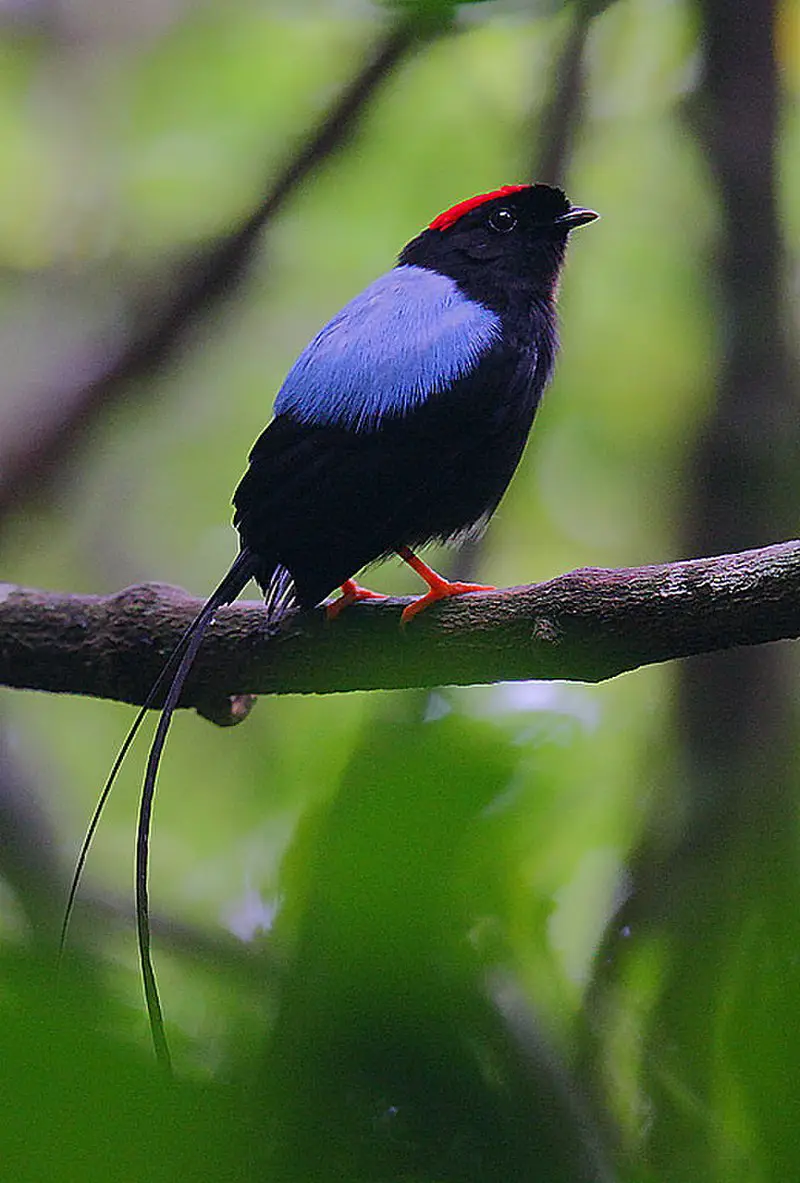
The Long-tailed Manakin is a small bird native to Central America. It inhabits both wet and dry tropical and subtropical forests, usually measuring just 10 centimetres (4 inches) long.
The male has striking black plumage with vivid blue back feathers, as well as a red crown atop its head.
Its most remarkable feature however are the two central tail feathers which have been greatly elongated over time – giving it an unmistakable silhouette in flight.
Females and juveniles display olive green colouring instead of the males’ more vibrant palette making for interesting contrast amongst family groups within these lush habitats.
Scientific classification:
| Kingdom | Animalia |
| Phylum | Chordata |
| Class | Aves |
| Order | Passeriformes |
| Family | Pipridae |
| Genus | Chiroxiphia |
| Species | C. linearis |
46. Yellow-Backed Oriole
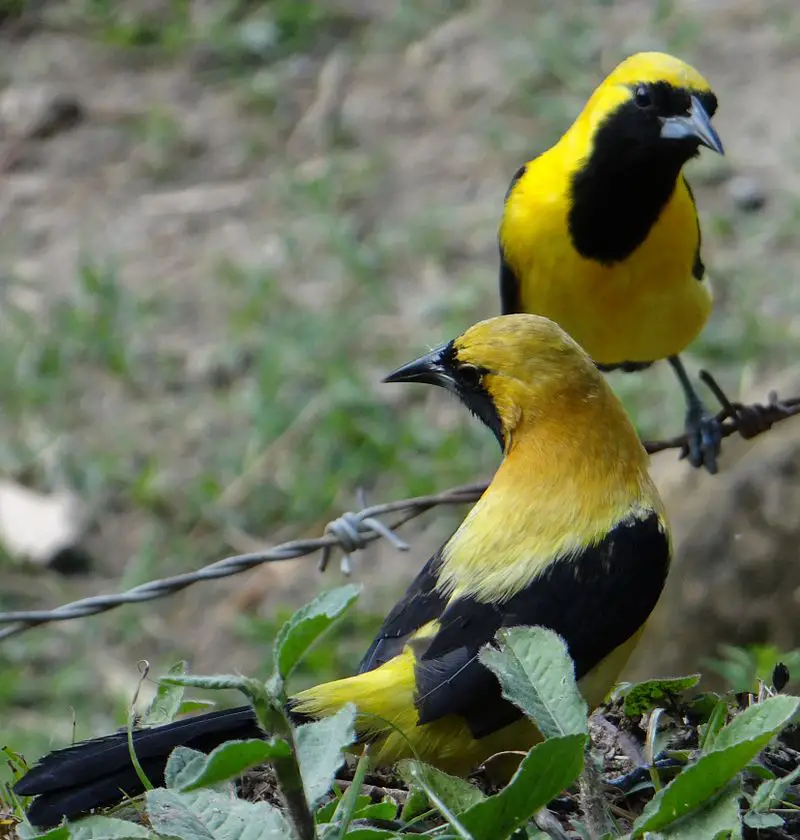
The Yellow-backed Oriole is a species of bird found in the Icteridae family. It has a yellow body and black bill, with its mandible base turning bluish grey when mature.
This medium sized oriole typically measures around 21.5 cm (8.5 inches) long from beak to tail and also features exposed skin and claws that are an intense blue-black colouring.
They tend to inhabit tropical regions such as Central America, Mexico, Costa Rica, Belize and Guatemala but can occasionally be spotted further north during migration season in Canada or even Texas.
These birds usually travel alone or in pairs so they don’t form large flocks like other species of orioles do.
However they have been known to gather together at certain times for feeding grounds or nesting sites before heading off on their own again shortly afterwards.
Scientific classification:
| Kingdom | Animalia |
| Phylum | Chordata |
| Class | Aves |
| Order | Passeriformes |
| Family | Icteridae |
| Genus | Icterus |
| Species | I. chrysater |
Also Featured In: Yellow Birds that Live in Yucatan,
47. Masked Tityra
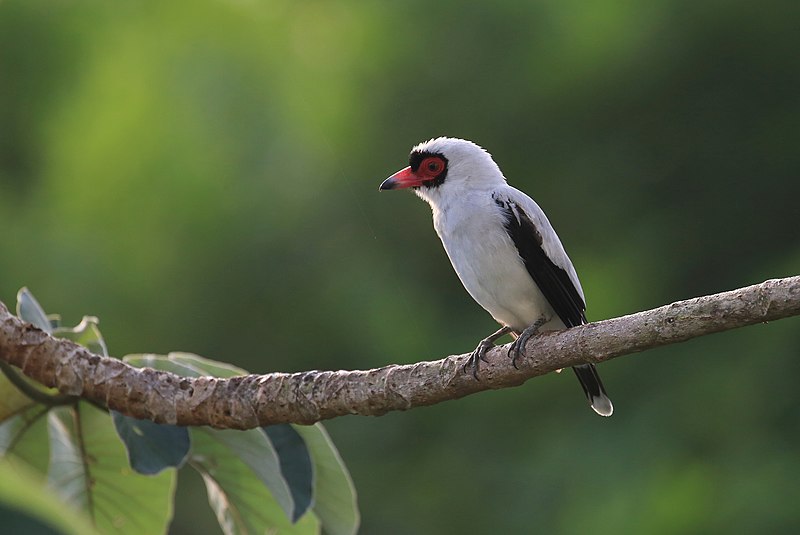
The Masked Tityra is a medium-sized passerine bird from Mexico, Central America and northern and central South America.
It has been traditionally classified as part of the cotinga or tyrant flycatcher family, however recent evidence suggests it should be better placed in its own family – Tityridae.
The masked tityra can typically be found inhabiting forests and woodlands within its range. This species appears to have adapted well to human presence since they often reside near settlements with small patches of remaining forest cover nearby.
Its striking black mask around the face combined with an overall brownish plumage make it easy to spot while perched on trees searching for food such as insects, fruits, lizards or frogs.
Scientific classification:
| Kingdom | Animalia |
| Phylum | Chordata |
| Class | Aves |
| Order | Passeriformes |
| Family | Tityridae |
| Genus | Tityra |
| Species | T. semifasciata |
Also Featured In: Birds that Live in Jalisco Birds,
48. Northern Potoo
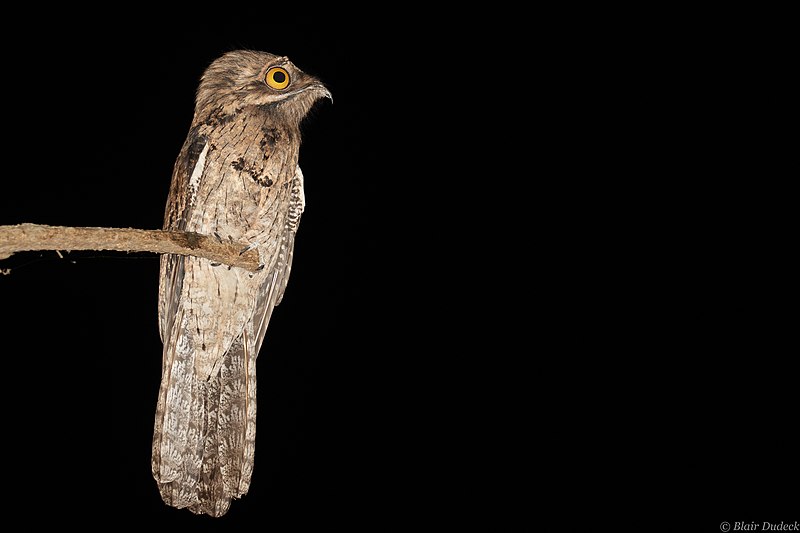
The Northern Potoo is a nocturnal bird belonging to the Nyctibiidae family. It inhabits Mexico, Central America and some of the Caribbean Islands such as Jamaica and Hispaniola where it can be found in tropical dry forests.
It was formerly classified as a subspecies of Common Potoo but due to differences in vocalizations they are now considered separate species.
This interesting bird has an almost comical appearance with its large head, long bill, short neck and disproportionately long legs that give it an awkward gait when walking on land.
Its plumage is mottled grey-brown which helps camouflage itself during the day while perched motionless on tree branches looking for prey at night.
The Northern Potoos call consists mostly or whistles ending with trills making them quite easy to identify within their range area.
Scientific classification:
| Kingdom | Animalia |
| Phylum | Chordata |
| Class | Aves |
| Order | Nyctibiiformes |
| Family | Nyctibiidae |
| Genus | Nyctibius |
| Species | N. jamaicensis |
49. White-Fronted Amazon
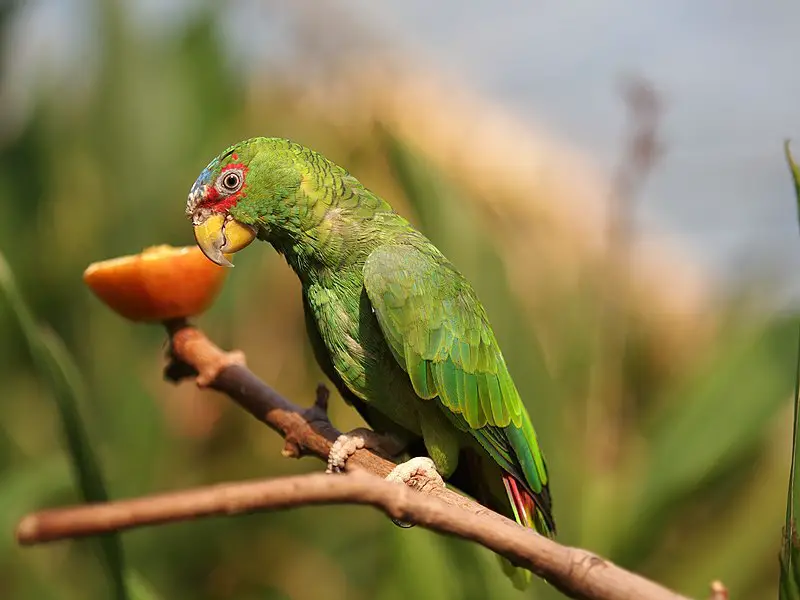
The white-fronted amazon is a Central American parrot that stands out for its bright colouring and ability to imitate around 40 different sounds.
It has an average life span of about 40 years, making it one of the longest living parrots in existence.
Despite being the smallest species among large parrots, measuring 25cm long, this bird still possesses strong vocal chords which can be heard from great distances.
They have beautiful yellow heads with distinctive white patches on their forehead and grey feathers covering their wings and tail.
These birds are very social animals who live in pairs or family groups within tropical rainforests and wetlands where they feed mostly on seeds found in trees such as palms.
Scientific classification:
| Kingdom | Animalia |
| Phylum | Chordata |
| Class | Aves |
| Order | Psittaciformes |
| Family | Psittacidae |
| Genus | Amazona |
| Species | A. albifrons |
50. Purple-Throated Mountaingem
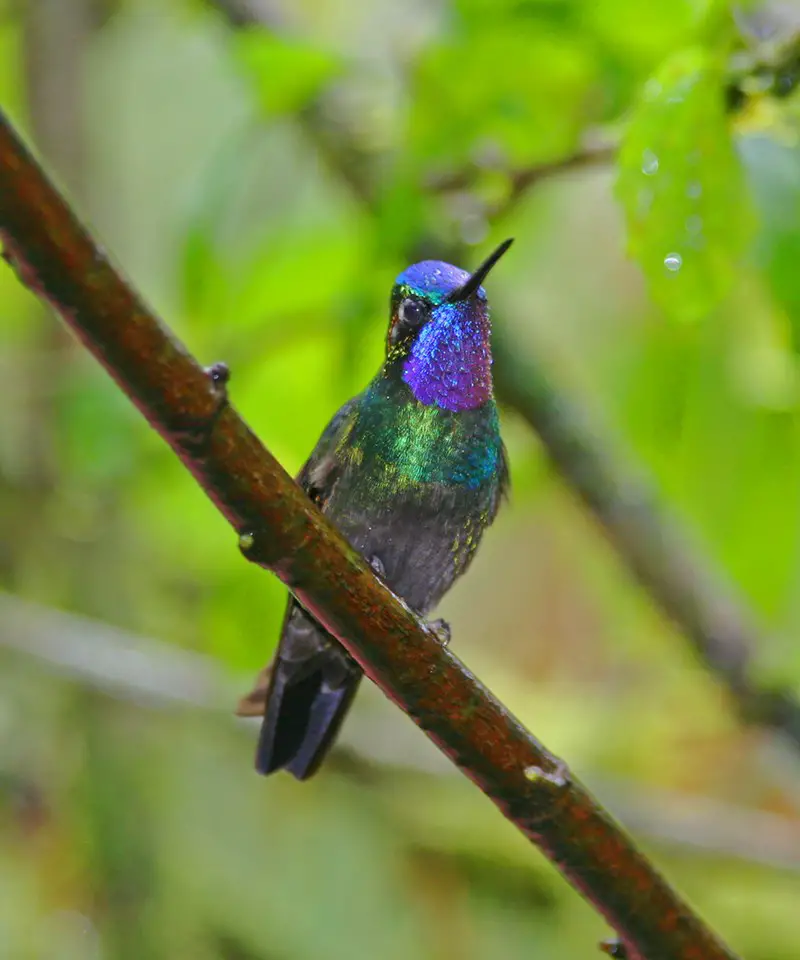
The Purple-throated Mountaingem is a species of hummingbird found in Central America. Its taxonomy has yet to be fully settled, and it is sometimes grouped with the White-throated Mountaingem and Gray-tailed Mountaingem.
This beautiful bird boasts vivid purple feathers on its throat which contrast against a grey body. It also has white stripes running along its sides that give this avian an elegant look.
The Purple-throated Mountain Gem feeds mainly off nectar from flowers but may supplement their diet with insects or spiders when necessary.
While they are not considered endangered, they face threats due to deforestation as well as climate change, making conservation efforts all the more important for them if we want these gorgeous birds around for years to come.
Scientific classification:
| Kingdom | Animalia |
| Phylum | Chordata |
| Class | Aves |
| Order | Apodiformes |
| Family | Trochilidae |
| Genus | Lampornis |
| Species | L. calolaemus |